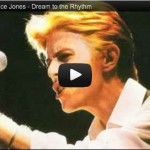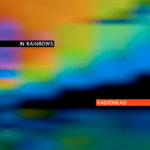A brilliant Grace Jones and David Bowie mashup.
Category: Music
-
Why I don’t read (or write) music reviews
“It’s music inspired by Disney films.” — Annie Clark on her new album, Actor (recorded as St. Vincent)
“One would hardly expect the phrase ‘Technicolor Disney nightmare’ to become an overused idiom anytime soon, but it’s a good bet you’ll see some iteration of it, written or otherwise, in just about every reference to this album.” — No Ripcord
“if it sounds a bit like the kind of dark, violent fairy tale Disney might have made had they not strayed so far from their Grimm roots, well, that’s a pretty fair take on the album as a whole.” — The Hurst Review
“imagine Trent Reznor scoring an old Disney movie—princesses and demons battling in a swirl of distorted synth noises, orchestral strings and pianos.” — Culture Bully
“Marrow is the perfect mix of Disney musical meets rock n’ roll.” — Sputnik Music
“The sophomore album from St. Vincent employs a cacaphony of sounds to create its Grimms brothers atmosphere. And indeed, Clark even looks like a Disney heroine.” — AOL Music
“The way that Clark’s trilling voice delivers melodies that skip and soars overtop richly-appointed arrangements, you could imagine these songs soundtracking any animated Disney film” — Chromewaves
“Estas canciones nacen como un score imaginario para escenas de cintas como Badlands, Picnic at Hanging Rock y algunos clásicos de Disney como La Bella Durmiente y La Dama y el Vagabundo.” — Flaming Milk
“And like a Disney flick, the tune has a happy ending, with a soothing mix of accordion, acoustic guitar, and skyward vocals. However, Michey Mouse [sic] probably won’t approve of Clark’s lyrics about ‘painting the black hole blacker,’ quarreling with a lover, and keeping secrets in a relationship. Oh, well.” — Spin
“Clark’s sweet vocals carry a tinge of malice, and set against the fanciful, dreamy arrangements, they often recall a golden-era Disney-villain.” — Tiny Mix Tapes
“Annie Clark may look like an animated Disney heroine sprung to life, and the influence of willowy, ethereal singers and songwriters such as Feist and Tori Amos is obvious.” — STNG
“The whole project at times seems Disney-ish in its aims, soaring with its whimsical orchestral arrangements and painting scenes that you really want to see brought to life in animation.” — Express Night Out
“‘The Stranger’, the ambulatory opening track of Actor, is indicative of St Vincent’s efforts: kitsch strings, reminiscent of 60’s easy listening or a mournful Disney soundtrack, give way to a storm of fuzzed-up guitar.” — Wireless Bollinger
“Even when the music is at its most dramatic, as when songs slip out of placid, Disney-esque string accompaniment into jagged, distorted guitar passages, Clark consistently understates her characters’ angst, and buries their negative emotions under layers of denial, stoicism, and subservience to the desire of others.” — Pitchfork
Okay, I like this one: “The fantasy of Disney is juxtaposed with the sweep of Morricone, David Mamet’s unsettling dramatic form and the alienation of Philip Roth.” — Music Remedy
-
Blipiography
Inspired by all of those “25 Things” memes floating around Facebook right now, I thought it might be fun to put together a mix CD that would be a kind of musical autobiography. But it turns out that reducing 36 years down to 80 minutes leaves too many holes, so, instead, I’ve coined a new term: “blipiography.” Each day in March I’m going to Blip a song. 31 days, 31 songs, ordered sequentially. I’ll update this post throughout the month, and you can also follow this little experiment on Blip.fm and Twitter. Each song will remain available online as long as Blip is able to find them. The blipiography is a fleeting gesture, I guess.
- “Artistry in Rhythm” by Stan Kenton
I am my father’s son. He still tells the story of how when he and my mom would put me down for naps, they’d tune the radio to the easy listening station and leave it beside the crib. I’ve been listening to Stan Kenton, The Four Freshman, Burt Bacharach, and a hundred big bands since I was in utero, and I suspect it’s the main reason I still need musicianship, harmonic complexity, and melody in my music. It’s certainly to blame for my too-long obsession with prog rock, but we’ll save that for another day (or three) midway through the month. This recording of “Artistry in Rhythm” now sounds to me like the soundtrack of a killer film noir — something with Ann Savage and Glenn Ford, maybe. And that piano break? Kenton’s hands must have been massive. - “Flowers on the Wall” by The Statler Brothers
I doubt I heard “Flowers on the Wall” more than once or twice between 1979 and 1994. As a kid, though, in the late-’70s, I used to pull out my parents’ Statler Brothers record, place it as delicately as I could on dad’s console turntable, and lower the needle again and again on this song. I think my audiophilia was probably born in those moments. Those of us who are buying up vinyl today — or, at least those of us over the age of 30 — are all nostalgists. We’ll argue the necessity of dynamic range and the virtues of old school mastering, but I think we’re really after the physical gestures — lifting the turntable cover, choosing a side, dropping the tonearm, reading the liner notes. It’s only fitting then, I guess, that cinema’s nostalgist par excellence, Quentin Tarantino, would drop the needle on “Flowers on the Wall” in Pulp Fiction. Sitting in that Tallahassee theater in 1994, I was shocked to discover I still knew all the words. - “Tom Sawyer” by Rush
I’ve written about this song before, but the short version of the story is this: a week or two after the release of Rush’s Moving Pictures I was at my friend Dave’s house, and his older brother played “Tom Sawyer” for us. I don’t remember now if we listened to the rest of the record, but we listened to “Tom Sawyer” over and over. And then I went home and told my mom I needed a copy of that Rush record — the one with the creepy cover and that awesome song on it. “Tom Sawyer” is probably more responsible for my love of rock music than any other song. Seven years later Rush was also my first big rock show — the “Hold Your Fire” Tour, featuring a video display, laser lights, an epic drum solo, and all the decadence a 15-year-old could handle. I still don’t have a f—ing clue what this song means. - “Magic” by Olivia Newton-John
When I began mapping out a playlist for this blipiography, the two periods that were hardest to pin down to just a few songs were my college years and pre-adolescence. College makes sense. I left home, started forging my own life, fell in love. Pre-adolescence came as a surprise, though. I suspect the music of that time is so vivid because it’s the moment when we first become aware of popular culture as an identity-defining marker (not that kids are able to describe it that way, of course). There are, for the first time, “cool” songs and “not cool” songs. Songs become directly associated with social experiences in ways they never have before. Picking one pop single from 1980-81 was tricky because all of them invoke for me the same kind of nostalgia. They all taste like pizza, sound like Space Invaders, and smell like roller skates. I settled on “Magic” partly because, like “Flowers on the Wall,” I haven’t heard it often over the years, so its affect hasn’t been softened by repetition — certainly not in the same way Queen’s “Another One Bites the Dust” and Kenny Rogers’ “The Gambler” have. Also, it’s a nice tune. And Olivia in 1980? Hot. - “Rosanna” by Toto
Again, I could have chosen a dozen other songs. I turned 10 in 1982 and got a small stack of classic rock albums for my birthday — Led Zeppelin IV, Van Halen I, Exit . . . Stage Left, Blizzard of Oz — but I was totally obsessed with pop music. On the way to church every Sunday morning I’d hear numbers 40-37 of Casey Kasem’s countdown, and we’d be back in the car, headed for lunch, just as he began the top 10. I mean, just look at the top songs of 1982. “I Love Rock and Roll,” “Centerfold,” “Don’t You Want Me?” “Eye in the Sky”! “Rosanna” is a big one for me, though, because: a. Toto IV was one of the first cassette tapes I owned and b. that synth solo. I was five years into my failed life as a pianist then and already owned my first Casio keyboard. The guys in Toto, I could tell, were musicians in a way that, say, Human League clearly weren’t. “Rosanna” is still a great pop song. Plus, it gets extra props for giving us the Porcaro shuffle. - “Panama” by Van Halen
I can so clearly picture me and my seven friends sitting around a table in the Magothy Middle School cafeteria, all of us wearing identical Van Halen concert t-shirts. They were baseball-style t’s, with 3/4-length black sleeves and a white body. It was the 1984 tour, the last one with Diamond Dave, and it made a one-night stop at the Capital Centre over in Largo. They played “Running with the Devil” and “Jamie’s Crying” and “Jump” and all of our favorites. It was awesome. Probably. I wouldn’t know, actually, because I didn’t go. In fact, only one of us went — Jason, who had an older brother and was willing to collect our money and buy our shirts. He handed them out the next day in our first period history class, and each of us walked a bit taller for a couple hours. In my memory, I associate all early-80s pop metal (VH, Def Leppard, Twisted Sister, Quiet Riot) with that history class. We talked about music constantly in there and did our best to dress the part, which, regrettably, in 1984 meant leather Nike hightops with dayglo laces, denim jackets with rock band pins (pre-Facebook flair), and, occasionally, tiger-striped bandanas. Yes, really. Eddie Van Halen was not only our guitar god; he was a fashion icon. Good times. - “Pleasant Valley Sunday” by The Monkees
In the summer of 1986 Mtv ran a Monkees marathon, and like thousands of other kids here in status symbol land, my sister and I became obsessed fans. My dad had the patience of Job on our family vacation that year — 14 hours from Maryland to the midwest, 14 hours back, and all we wanted to listen to were the two Monkees tapes we’d been able to find. (Mickey, Peter, and Davey were as shocked as anyone by their newfound fame. Most of their music had gone out of print.) In late-August, just before school started, we even managed to see them in concert (my first) on a bill with Herman’s Hermits (minus Peter Noone, a.k.a. Herman), The Grass Roots, and Gary Puckett & the Union Gap. Like most young crushes, my interest in The Monkees faded quickly. But years later, after I went off to college, I heard a band cover “Pleasant Valley Sunday” and realized for the first time what a smart and killer pop song it is. Like so many of The Monkee’s hits it was written by hired guns, in this case Gerry Goffin and Carole King. For the record, my favorite Monkees song is still Mike Nesmith’s “Sweet Young Thing,” which, unfortunately, can’t be found by Blip right now. - “Pretty in Pink” by The Psychedelic Furs
That John Hughes wrote and produced a film of the same name in 1986 is totally a coincidence, I assure you. Thanks to the greatest radio station ever, WHFS 99.1, I’d been made aware of the Furs long before Molly Ringwald sewed that dress and broke Duckie’s heart. Young love is the reason for this selection, though. In the spring of ’87 my folks took my sister and me on a European vacation, and while there I met a girl in our tour group. My first real crush. She was there with her high school French class, and by the end of the second day of the trip we were sitting together on every tour bus, learning how to talk to each other. It all came rather easily, which was a pleasant surprise given how shy I was. We exchanged letters for several months afterwards and then, eventually, inevitably, fell out of contact. I bought two tapes in a little store near Canterbury Cathedral, U2’s The Joshua Tree and The Psychedelic Furs’ Talk Talk, and listened to them constantly that summer. Every song from both albums, but especially “Pretty in Pink” and the last few tracks on side 2 of Joshua Tree, still remind me of young love, which is a feeling worth remembering, I think. - “Sheep” by Pink Floyd
So many ways to write about this song. There’s my first job at Subway, where I worked with a girl who had a huge music collection and who one day handed me a 90-minute cassette tape with Animals and Wish You Were Here on it back-to-back. There’s the night in the spring of ’88 when I stood somewhere around the 50 yard line of RFK Stadium and watched the reunited Pink Floyd work through so many of their songs (though not this one, regrettably). There’s all those nights throughout high school when we’d listen to this and other albums in Paul’s bedroom or while driving around in his old Camry. I hope all young music fans still go through a Pink Floyd phase, and I hope they still listen to Animals. I picked “Sheep” because of Rick Wright’s opening solo (I still play it to test a keyboard’s Fender Rhodes patch) and because it’s Roger Waters at his most misanthropic. - “Medicine Show” by Big Audio Dynamite
I could put together an exhaustive “Darren working fast food jobs” playlist, but no one would want to hear it because it would consist mostly of late-’80s pop hits like “Never Gonna Give You Up,” “Got My Mind Set On You,” “Wind Beneath My Wings,” and “My Prerogative.” Lord help me. How did pop music get so bad, so fast? Fortunately, someone at Subway had managed to wire an old tape deck into the store’s audio system, so we’d get a reprieve from the “freshest mix of 80s hits!” as soon as the manager left. One of my coworkers at Subway — the same girl who gave me the Pink Floyd cassette — brought in This is Big Audio Dynamite one night, and it was really unlike anything I’d heard before. Like every other suburban white kid in the ’80s I’d learned about sampling from Fat Boys records and Licensed to Ill, but I’d never heard it used in the context of rock or new wave music. I wonder how much cred I’ll sacrifice by admitting that I came to The Clash by way of B.A.D.? - “Heart of the Sunrise”
Next week, when I get to the college years, I’ll probably be so distracted with all the talk of meeting Joanna and falling in love and, oh yeah, going through my jam band phase, that I might forget to mention the fact that for two years there I planned to become a composer. I managed to not suck just enough in my audition to be admitted to Florida State’s music school but quickly discovered, upon arriving there, that I did not — and would not ever — possess either the chops or the desire necessary to be anything more than a casual musician. For a short time, that realization broke my Rick Wakeman-loving heart. In high school nearly all of my closest friends were musicians (and I’m pleased to discover through the magic of Facebook that many of them have managed to make a career of it). And because we were real musicians, we loved prog rock — the more obscure, syncopated, and navel-gazing, the better. Incomprehensible lyrics? Yes, please! Concerts performed on ice? Absolutely! Tolkein-like album covers? Totally! I still pull out several of those records from time to time — the first King Crimson album holds up really well, as do the ones from the 80s with Adrian Belew and Tony Levin; I like parts of the Gabriel-era Genesis records; and there are three or four Yes albums that still make me want to get out my Hanon. “Heart of the Sunrise” is as good as prog rock will ever get. - “Terrapin Station” by The Grateful Dead
To quote our President, “I inhaled frequently. That was the point.” - “Three Days” by Jane’s Addiction
Like every other 19-year-old music fan in 1991, I played the hell out of Nirvana’s Nevermind and Pearl Jam’s 10, but I never felt a connection with the grunge movement. I was still living at home in our middle class neighborhood, going to a community college, and feeling relatively content. I was too pampered and naive to be alienated. It was only a couple years later, after I met Joanna and inherited her copies of Facelift and Dirt, that I made any personal connection to the Seattle sound. It’s still a good day for us whenever “Man in the Box” comes on the radio. In the summer of ’91, I did go to the first Lollapalooza, though. A couple random memories: drinking beer in the parking lot beforehand and regretting it almost immediately; watching my friend Andy run headlong into the pit during Henry Rollins’ opening set and not finding him again until eight hours later; chatting up Ice-T, who was out exploring the fest after his set with Body Count; seeing thousands of empty water bottles being tossed around while Siouxsie and the Banshees were on stage; retreating to a tent during Nine Inch Nails, due to a screaming headache (beer + heat = wicked dehydration); finding a comfortable spot 100 yards from the stage, taking a seat, and watching Jane’s Addiction close out the night. - “Two Trains” by Little Feat
I’ve written several times before about my deep love for Little Feat, so I’ll keep it short. If told to pick just one album before shipping off to a deserted island, I’d almost definitely grab my copy of Waiting for Columbus, their epic live recording from 1978. Lowell George died too young, damnit. He was barely 34, two-and-a-half years younger than I am now, and still had so much great music left in him. (Plus, I bet he would have gotten a real kick out of seeing his daughter’s recent successes.) This live recording of “Two Trains” from 1974 catches him near his peak. - “I Got the News” by Steely Dan
Yes, this blipiography now includes a guest vocal from Michael McDonald. Somewhere, Joanna is rolling her eyes. My love of Steely Dan is untarnished by irony, I assure you. Midway through my first year at the local community college, I abandoned my efforts to swallow the overwhelming, soul-destroying boredom I experienced each time I walked in to Calc 2 and, in the process, also abandoned my plans of becoming an engineer. Instead, I found the music department, registered for a couple theory and history courses, joined the jazz band, and declared myself a music major. All of us in the rhythm section were rock fans first, jazz second, and Steely Dan was the perfect middle ground. One day one of the guitarists (there were three, as I recall) challenged me to pick out the chord clusters in “I Got the News,” which I proceeded to do, and we hacked our way through a few measures. Aja is still one of my favorite albums. - “Goodbye” by The Sundays
Today’s selection came down to a three-way race between “Sister Cry” from Hollywood Town Hall by The Jayhawks, “Try Not to Breathe” from Automatic for the People by R.E.M., and this great track from The Sundays’ second album, Blind. All three came out in 1992, and all three were in heavy rotation in my Cawthon Hall dorm room. Although it’s been a while since I tried, I bet I can still sing along with every word of that Jayhawks record, which was my first exposure to alt-country and which is full of brilliant pop songs that even a hack like me could play on an acoustic guitar. I remember buying the R.E.M. album solely on the strength of the 5-star review in Rolling Stone. It’s still my favorite of theirs. I went with The Sundays, though, because many of my fondest memories of that first year away at school revolve around live music. The Sundays played a show at The Moon in early-’93, and it was on that night, standing just a few feet from Harriet Wheeler, that I first understood the groupie phenomenon. - “Driving Song” by Widespread Panic
I think I may have mentioned earlier that I smoked quite a bit of weed in the early-90s. Hence my jam band phase. It all started with the first Blues Traveler record, which led me to the first H.O.R.D.E. festival, which led to The Aquarium Rescue Unit and Phish and, yes, The Spin Doctors, all of whom made frequent stops in Tallahassee. My favorite, though, was Widespread Panic, who I must have seen 7 or 8 times, including once at the legendary and long-demolished Hammerjacks in Baltimore, where John Bell and I drank some beer together. I totally get the jam band scene — I remember experiencing some fairly ecstatic moments at those shows — but even a relatively interesting track like “Driving Song” just doesn’t do much for me these days. - “A Different Drum” by Peter Gabriel
One of the bigger challenges of this blipiography was deciding where to insert Peter Gabriel. I considered mentioning the release of So in 1986, which was the first album of his I ever owned. Or I could have put him in my high school years, when I threw myself into his earlier releases (Security remains one of my desert island discs). Us is another album I associate with dorm life, and that tour was the only time I’ve ever seen him live. But Passion, Gabriel’s soundtrack for Martin Scorsese’s The Last Temptation of Christ, is probably the recording I’ve listed to most often over the years, and it’s also the first CD I ever gave to Joanna. We were just hanging out together as friends then, and I remember suggesting it might be good music to help her fight through some writer’s block. The next semester she used another track from the album to score her first short project in film school. This will be the first of three or four entries that all remind me of young love. - “When It’s Raining” by The Samples
I think I first heard The Samples in the summer of ’93, when they played at the second H.O.R.D.E. festival. That was a tough summer. Joanna and I had begun seeing each other as friends that spring, so the last thing I wanted to do was return to Maryland for three months of summer school at the community college. I’d get up most mornings around 10, make deliveries on the lunch shift at Pizza Hut, sleepwalk through physics class, then go out with friends. I remember coming home one night and telling my mom I might be having a breakdown. I spent a lot of time alone in my car that summer, listening to the Cocteau Twins, Chris Isaak, the massive collection of Stax singles, and No Room by The Samples. That CD remained a permanent fixture in my car throughout the fall, when I returned to Tallahassee and fell desperately in love with my wife. - “Possession” by Sarah McLachlan
Sarah McLachlan’s 1997 release, Surfacing, won a couple Grammys and sold 11 million copies, and that success repositioned her in the music marketplace. Her first two records were played on college radio stations, and her early vidoes (“Into the Fire”) could only be spotted on Mtv’s 120 Minutes. I say all of that to say this: It’s difficult now, more than a decade after McLachlan became Ms. Lilith Fair and that singer your aunt really likes, to remember how impressive a single “Possession” was when it was first released. I still don’t know how to write about love, but it occurs to me suddenly that Fumbling Toward Ecstasy was an appropriately-titled soundtrack for Joanna’s and my early years together, when we struggled to drop our guards and trust each other. - “Strange Waters” by Bruce Cockburn
After we got married, Joanna and I moved to Wilmington, NC, where I spent a year-and-a-half enjoying myself in graduate school and she spent way too many days working crap jobs and praying for it all to end. God bless her. Wilmington just wasn’t the right place for us. It never felt like home. Which is maybe why I’m only picking one song to represent our time there. “Strange Waters” is one of my favorite songs, and I’m in the habit of calling it my all-time favorite hymn. “Everything is bullshit but the open hand” is just about a perfect summary of my theology. When I asked Bruce about the song years later, he said, “I’m saying to God, [laughs] ‘Somebody said you would lead me beside still waters.’ But that hasn’t been my experience. These waters are fairly troubling. And yet it’s going where it has to go, and so clearly. It feels clear to me, anyway.” - “Pyramid Song” by Radiohead
I lost track of Radiohead between “Creep” and Amnesiac, which is the album that made me a fan. And, honestly, I might not have paid too much attention to it either if some editor at TCM hadn’t cut together this brilliant promo for their Tarkovsky series. I launched Long Pauses in 2001, inspired largely by my obsession with Tarkovsky’s films. At the time, only a few were yet available on DVD, so TCM’s series was an event for me. It was my first opportunity to see Ivan’s Childhood and Chris Marker’s brilliant essay, One Day in the Life of Andrei Arsenevich, and was a significant catalyst in my cinephilia. Generally, Joanna is not a great fan of live music, but seeing Radiohead a couple years later was a thrill for both of us. - “Lowdown” by Wire
I was a late-comer to punk and post-punk. Maybe this is related to my earlier comment about grunge — that my life was too sheltered and polite to ever allow any acknowledgment of profane emotion (not that the exercise of profane emotion is the only appeal of loud, fast rock and roll). Anyway, through an alignment of the stars I can only describe as Divine, I happened upon punk and post-punk just as Napster hit, which meant that I suddenly had a hard drive full of The Clash, Pavement, The Fall, The Minutemen, Television, The Stooges, and The Ramones. But Wire’s Pink Flag was, and is, my favorite of the lot. “Lowdown” gets the nod for its unexpected and miraculous appearance in Pedro Costa’s film Ossos. - “I Heard You Looking” by Yo La Tengo
Years ago, I wrote about my first Yo La Tengo show, which also happened to be the first and only time anyone has ever threatened to kick my ass. I’d made the mistake of telling some drunk asshole to shut up. Didn’t he notice that Ira was singing a quiet song? Or that Ira was standing ten feet away? Anyway, my newfound love of YLT seven or eight years ago coincided with my newfound love of noise, and Ira can orchestrate distortion with the best of ’em. Painful remains my favorite of their albums. - “This Is Love” by PJ Harvey
- “Carry Me Ohio” by Sun Kil Moon
- “Political Scientist” by Ryan Adams
- “A Good Man is Hard to Find” by Sufjan Stevens
- “Drunken Butterfly” by Sonic Youth
- “Remember the Mountain Bed” by Billy Bragg and Wilco
- “Like a Rolling Stone (live)” by Bob Dylan
- “Artistry in Rhythm” by Stan Kenton
-
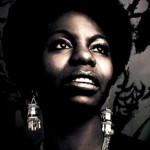
2008 Mix
Side A
- “Moneda Sucia” by Flormaleva (opening title music from Liverpool)
- “Magick” by Ryan Adams & The Cardinals (from Cardinology)
- “Replica” by Beck (from Modern Guilt)
- “Jazz” by Esbjorn Svensson Trio (from Leucocyte)
- “Lassoo” by The Duke Spirit (from Neptune)
- “Strange Overtones” by David Byrne and Brian Eno (from Everything That Happens Will Happen Today)
- “Man Made Lake” by Calexico (from Carried to the Dust)
- “Betray” by Son Lux (from At War with Walls and Mazes)
- “Mississippi Goddam” (by Nina Simone from To Be Free: The Nina Simone Story)
Side B
- “Only for a Moment” by Black Taj (from Beyonder)
- “We Call Upon the Author” by Nick Cave & The Bad Seeds (from DIG, LAZARUS, DIG!!!)
- “Gold for Bread” by Blitzen Trapper (from Furr)
- “Threads” by Portishead (from Third)
- “Blue Ridge Mountains” by Fleet Foxes (from Fleet Foxes)
- “Inside a Boy” by My Brightest Diamond (from A Thousand Shark’s Teeth)
- “De bonnes raisons” by Louis Garrel and Ludivine Sagnier (from the soundtrack of Love Songs)
- “Dreamin’ of You” by Bob Dylan (from Tell Tale Signs)
- “Eat Yourself” by Goldfrapp (from Seventh Tree)
- “A Change is Gonna Come” by Sam Cooke
If the Side A/Side B thing seems pretentious, there’s at least a little method to my (nostalgic) madness. See, ideally, one who listens to this mix will take a short break after Nina Simone’s “Mississippi Goddam.” Frankly, I don’t know how anyone could hear that song and not need to stand up, walk around, pour a stiff drink, smoke a cigarette, something. Recorded live just a few days after the murder of Martin Luther King, Jr., it’s as painful an expression of rage and sorrow and disillusionment as you’re ever likely to hear. The lyrics alone are enough to get me, but, goddam, listen to Nina’s voice when she sings (at 6:17):
Why don’t you see it?
Why don’t you feel it?
I don’t know . . .
I don’t know.Nina’s mourning Medgar Evers, four little girls, and, as she calls him, “the King of Love.” I won’t pretend I can empathize with her, and I don’t mean to strike a ridiculous pose of suffering (is there anything more insufferable from a wealthy white guy?), but I offer this recording as a summation of my myriad feelings about the George W. Bush era and about this strange and terrible place that I love and where I have chosen to make my home. To paraphrase another blogger, “If you hear this song and feel moved to tears, then you are a kindred spirit.” Actually, I’d be content to reduce this entire mix down to just three songs: “Mississippi Goddam,” “We Call Upon the Author,” and, for obvious reasons, “A Change is Gonna Come,” which is not a new song, of course, but which has become new in a new context.
2008 is dead. Long live 2008.
Long Pauses was inspired, years ago now, by a Denise Levertov poem that compares the act of writing to the existential adventure of composing of one’s life. “Making Peace” opens with the image of “A voice” calling out from the darkness, which I’ve always taken as an allusion to God; like Levertov in her later years, I still call myself a Christian, even if a somewhat unorthodox one. By Levertov’s calculus, “the poet” — whether a literal artist or, figuratively, an individual composing her life — is imbued with a creative imagination and the will to exercise it. We are holy potential. We are capable of great things, she suggests — “peace,” “justice,” “mutual aid” — if only we choose to shake our lives free of “the imagination of disaster.” It’s all a beautiful extended metaphor, culminating in this description of something like grace:
A cadence of peace might balance its weight
on that different fulcrum; peace, a presence,
an energy field more intense than war,
might pulse then,
stanza by stanza into the world,
each act of living
one of its words, each word
a vibration of light–facets
of the forming crystal.Lovely. And still inspiring after all these years. But after listening to “We Call Upon the Author” twenty or thirty times, I’m tempted to start another blog that shifts Long Pauses 20 or 30 degrees on its axis — a site that is more profane and bitter and funny. I’d call it “Prolix!!!! Prolix!!!!” and it would be a kind of fiery Jeremiad. It would be considerably less lovely. In “We Call Upon the Author” Nick Cave also calls out to the Author/Creator but he finds one with a bit of an “imagination of disaster” problem Himself. There’s no vibrating lights or facets of forming crystals in Cave’s America. It’s a much more recognizable place: “rampant discrimination, mass poverty, third world debt, infectious disease, global inequality, and deepening socio-economic divisions.” Come on, Author, can’t you cut some of this shit? “Prolix! Prolix! Nothing a pair of scissors can’t fix!”
In other sounds . . .
I haven’t heard enough new music this year to justify putting together a Top 10, but the other 16 songs here represent a good deal of what I’ve been listening to. According to iTunes, “Inside a Boy” wins the “play count” race for the year, which seems about right. “Strange Overtones” is my favorite pop single (if it’s accurate to call a Byrne/Eno song a pop single) since Kelly Clarkson’s “Since You Been Gone.” “Magick” is a pretty great pop song, too — one of many on Cardinology, the tightest collection Ryan Adams has ever released. And “Dreamin’ of You” proves, to no one’s surprise, that Bob Dylan’s rejects and cutouts are golden.
Beck, Son Lux, Portishead, and Goldfrapp all put out really good records that find crazy beauty in electronic noises. Calexico, along with new-comers Fleet Foxes and Blitzen Trapper, mined different veins of Americana and found some jewels. The Duke Spirit and Black Taj made two of the best guitar-driven rock albums I’ve heard in quite a while. And as a film guy, I also had to include two cuts from movies I loved this year: “Moneda Sucia,” Flormaleva’s surf-y opener from Lisandro Alonso’s Liverpool, and “De bonnes raisons,” Louis Garrel and Ludivine Sagnier’s pop-y duet that opens Christoph Honore’s Love Songs. Ah, Ludivine. Be still my beating heart.
The much-coveted “Long Pauses Song of the Year Award” goes to “Premonition: I. Earth” by The Esbjorn Svennson Trio (E.S.T.), which wasn’t included in the mix because, at more than 17 minutes, it would have eaten up a fourth of the disc. I added “Jazz,” instead, which is a somewhat more traditional piano trio performance. “Premonition: I. Earth” is like something from another planet. E.S.T. was formed 15 years ago, and Svennson and drummer Magnus Ostrom played together even longer. You can hear that history in the precision and invention of their improvisations. I only wish I’d had a chance to see Svennson perform live.
Top 10 Live Shows of 2008
The ordering of this list is determined largely, I’ve realized, by where I was sitting and by the energy in the room. Sonic Youth is the only band that still makes me bounce around in a pit with kids half my age; Wilco, who are probably America’s Great Rock Band right now, put on an amazing performance, but I was too far away from it and spent too much of the night feeling like a spectator rather than a participant.
- Sonic Youth
- Tom Waits
- Emmylou Harris, Patty Griffin, Shawn Colvin, and Buddy Miller
- My Brightest Diamond and Clare & The Reasons
- The Duke Spirit and Black Rebel Motorcycle Club
- Lou Reed
- David Byrne
- Elvis Costello
- Iron & Wine and Blitzen Trapper
- Wilco and John Doe
Send me your mailing address if you want a copy of the mix. I’d love to get something in return, but it’s not necessary.
-
Strange Waters: A Conversation with Bruce Cockburn
A recent post at Pop Dose devoted to “If I Had a Rocket Launcher” reminded me of this interview I did with Bruce Cockburn nearly four years ago. Time flies. This conversation was originally published in Issue 14 of Beyond magazine and is republished here with their permission.
• • •
“If ever there was a need for a Jeremiah to come along and to rant at us, it’s now.”
I actually laughed when he said it—partly because, in context, it was funny (he laughed too); partly because it’s exactly the type of thing one expects to hear from Bruce Cockburn, a songwriter who has devoted the bulk of his four-decade career to documenting our many strange failings and fears. The temptation when writing about Cockburn is to transform him into just such a prophet, to imbue his songs and his public persona with a moral seriousness that unfairly eclipses all that makes his music so wonderfully human. If Cockburn’s characters, like the Old Testament Jeremiah, occasionally weep and wail against some approaching doom, they are just as likely to be touched by humor or mischief or lust, and they nearly always manage to transcend the circumstances of their daily lives, if only for a moment.
Cockburn also writes great love songs and plays a mean guitar.
After studying at the Berklee School of Music in Boston and gigging with a string of rock bands around Ottawa, Cockburn released his first collection of original material in 1970. His list of accomplishments since includes more than 25 albums, eleven Juno Awards, three honorary Ph.D.s., and a membership in the Canadian Music Hall of Fame. Cockburn has also been honored for his humanitarian work, which has taken him, among other places, to Nicaragua, Mozambique, Cambodia, communist Europe, and, most recently, Iraq. Each experience has eventually found its way into songs like “If I Had a Rocket Launcher,” which rages against the injustice of America’s military intervention in Central America, or “Last Night of the World,” which marvels at an encounter with “hope among the hopeless.”
Violence shone a different light on everything
Suddenly it’s repression, moratorium on rights
What did they think the politics of panic would invite?
Person in the street shrugs — “Security comes first”
But the trouble with normal is it always gets worse— The Trouble with Normal” (1981)
Cockburn is finally home again. In June 2003, he set off on tour in support of his latest CD, You’ve Never Seen Everything. It’s a typical Bruce Cockburn album: a collection of songs built from journalistic images and virtuoso musicianship that documents our world with equal measures of wonder, anger, awe, and exasperation. The post-9/11 world, these songs suggest, is a place of grave danger, irrational fear, and, as Cockburn sings in the title track, “unbelievable indifference.” But there is also, despite it all, a blossoming potential for spiritual and political awakening. “I’m still here,” Cockburn intones on the opening cut. “I’m still here.”
After nearly a year-and-a-half and multiple swings through North America, Europe, and Australia, Cockburn’s tour wrapped in November 2004, the same month that saw the re-election of George W. Bush. Given the timing of our conversation and the content of You’ve Never Seen Everything, the U.S. presidential election seemed a logical place for us to begin.
Beyond: Does the political climate in which you’re touring affect the shows in any specific ways?
Cockburn: Normally not, really. I guess it obviously affects the mood of the audience to some degree, but I don’t notice that when I’m on stage. I mean, people are into the show or they’re not. And most of time they are, so that’s what you feel, more than the specifics of what they brought with them.
But it affects me, too. I wasn’t totally surprised by the outcome of the election, but obviously it was disappointing. We have to live with what we have to live with for the foreseeable future. Another four years is going to take a long time to correct. We’re going to be living with the Bush world for a long time. That’s the way it is, and it’s regrettable, but we have to find some way to deal with it.
Beyond: There’s something especially maddening about Bush’s use of “moral values” rhetoric to sell a political ideology.
Cockburn: It’s toxic as all get-out. These guys, these smug [pause] people—polyester-clad people … [laughs] I guess it’s not fair to imply that kind of designation because other kinds of people wear polyester, but, you know, it’s the smugness that is just rank. If ever there was a need for a Jeremiah to come along and to rant at us, it’s now. These people need to be shaken, and I’m afraid that they will get shaken, but in the process they’re going to make sure that the rest of us get shaken too. And in some very ugly ways. It’s worrisome.
Beyond: I would imagine that there are particular songs that people want to hear right now. Like, I think I would be disappointed if you didn’t play “The Trouble with Normal.”
Cockburn: [laughs] Well, the same old, same old. That song’s twenty years old and it still fits. It could be fifty years old and it would still fit, probably.
People have their own particular preferences. The songs I hear people hollering out for most are the personal songs: “All the Diamonds,” “Pacing the Cage,” “Waiting for a Miracle.” Occasionally, someone will call out for “The Trouble with Normal.” And “Rocket Launcher,” of course. If I haven’t played it in the show, it’ll get a big howl for the encore. A lot of people are relating to that song. Everybody associates the frustration and anger they feel with “Rocket Launcher,” I think.
Beyond: Generally speaking, it seems that your more explicitly political songs take one of two paths. One path I think of as “snapshot songs,” where you just shine a light on a particular moment and bring it to life. Like, I was thinking of “Dust and Diesel,” where you capture something of the political climate of Nicaragua in that image of a smiling girl directing traffic with a .45 strapped to her cotton dress. And then there are songs like “The Trouble with Normal” that seem to be a more polemical voice of righteous anger.
Cockburn: Yeah, and they’re more general in their targeting. “Call It Democracy” would be in that category, too. It’s specifically aimed at the policies of the International Monetary Fund, but that’s representative of a whole system of things, which is the real problem. “Rocket Launcher” fits that former category, too, of trying to capture a moment. It was how I felt when I experienced a particular . . . the sense of being with those refugees who had experienced those things.
I don’t rationalize that much before I write a song. After the fact I can kind of tell what, if any, category it belongs in. But when I’m writing a song, I’m thinking about whatever feelings I have that want to be written down. Sometimes it’s anger, sometimes it’s hope, sometimes it’s fun, sometimes it’s sex, sometimes it’s encounters with the Divine, which certainly qualify as expressions of a moment because the contact generally doesn’t last long. I write all of the songs the same way, the mechanism’s the same. Different feelings come up, different triggers switch that get those feelings moving.
Beyond: You seem to have an obsession with images of light and dark. There’s a certain metaphorical quality to that, of course, but what most attracts me to those moments is that so many of your songs are composed like a photograph or like a sequence in a film. Was that an organic development for you?
Cockburn: It grew over time. I don’t think it started out like that. “Going to the Country” [from Cockburn’s debut album] is sort of a proto-version of that approach, maybe. Most of the songs on that album are a bit less focused. “The Bicycle Trip” is sort of goofy, and I don’t really count that, but “Spring Song,” “Man of a Thousand Faces,” “The Thirteenth Mountain”—they’re describing a state of things, and it’s a state that is sometimes sought after, it’s a state that happened already.
But over time the angle of approach shifted slightly, and I began to write more and more in a style that I think you rightly described as “cinematic.” I think of it that way, sometimes, when I’m thinking about it at all. It’s evident to me that that’s what I’m doing. Putting a song together in terms of little scenes. And the chorus, if there’s a chorus, will tie them together or bridge them. I do that a lot. I watch a lot of movies. Maybe that’s why. [laughs]
Beyond: “Tokyo” seems to fit that category. There’s even a line where you’re describing a car accident and it actually says, just like a screenplay, “Cut to crumbling guard rail.”
Cockburn: I started writing “Tokyo” on a plane home from what I think was probably the second trip to Japan, in the late-‘70s. That accident scene that it describes—I mean, I didn’t actually see it going into the river—but, on the way to the airport, we drove past that. I don’t know if it’s as true now as it once was, but touring in a place like Japan made one’s emotions open, made your heart open, because you’re so dependent on people. Not only do you not understand the words that you’re reading, but you can’t understand the letters they’re written in. So you’re completely dependent upon the people around you for everything. That state of dependency, I found, made me particularly vulnerable. So passing that accident scene at the end of what was really the fantastic experience of this whole tour seemed to . . . well, it was particularly intense because of that state.
I was feeling it out on the plane after I’d left and just tried to capture something of what it felt to be in Tokyo with that included. The accident scene stood in stark contrast to everything else about Japan. Everything else that I experienced was positive, pretty much. Even the drunk guys pissing in the street. It was colorful and amusing and down-home in a funny kind of way—all these guys in business suits acting like this. So even that was positive. And here was the violence of this accident, which shone a different light on everything.
Beyond: Like “Tokyo,” so many of these “snapshot” songs are tied to the place that either inspired them or where they’re actually located. Inner City Front, for example, plays like a map of Toronto.
Cockburn: Yeah, it’s really geographically specific, down to the street names. I was living on Smithern Avenue when I wrote that, in the neighborhood that it’s describing. That “cinematic” thing, it may have started with the Humans album: “Tokyo” and a few other songs on that album. I’m not sure. I’d have to dig back and see if it was as apparent before that. But by the time we get to Inner City Front, it’s really full-on, conscious, “I’m painting a scene now, and the next verse is going to be a different scene, and they’re related in various ways.”
The eternal things are eternal
There’s a rainbow shining in a bead of spittle
Falling diamonds in rattling rain
Light flexed on moving muscle
I stand here dazzled with my heart in flames— “World of Wonders” (1985)
“You Pay Your Money and You Take Your Chance,” the opening track of Inner City Front, includes one of Cockburn’s most striking images. It’s a street scene at night, and the narrator has been drawn from his apartment by the sound of a screaming woman.
By the time I reach the corner they’ve all vanished
Just a deaf kid talking like Popeye to a large fleshy laughing man in a blue shirtLike a Flannery O’Connor story, the song is an intersection of grotesque characters that ends with an unexpected glimpse of grace: “And through it all, somehow, this willingness that asks no questions.”
Cockburn: Yeah, well, grace. Grace lives in the dirt, you know?
Beyond: Right.
Cockburn: If you want to call it “dirt.” I don’t know if that’s exactly how I think about it. If you’ve got to wait until you’re sitting out on a mountaintop somewhere to experience grace, you’re probably going to miss it. [laughs] It’s not really grace then. You’ve constructed an atmosphere for yourself to get in touch with an aspect of yourself. But it’s that gleam in a “bead of spittle.” That’s where the grace is. It’s all over the place.
Seeing it in other people, for me, has always been more difficult than finding it in a landscape or in something that happens to me or in some other subjective thing. But occasionally I get lucky and I get to see it in people, too. Or, at least—I mean, I see it in people fairly often—but I see it in a way that can be translated into part of a song.
Beyond: Those moments are sprinkled throughout your songs. Like, “In the Falling Dark,” with its images of the “hard-shelled husbands and wives”—these mundane images of everyday life that are illumined by something sacred. And then all the way up to You’ve Never Seen Everything with “Everywhere Dance”: “The Dance is truth, and it’s everywhere.”
Cockburn: Not everybody hears this, but I think the song “You’ve Never Seen Everything” is talking about that, too. The whole point of that song is, this shit is happening all around us and we can’t ignore it. And we shouldn’t try to ignore it. We should deal with it. But you’ve got to remember that that’s not the only thing there is. The song kind of goes at it from a negative perspective, because it’s saying “here’s all this stuff and we don’t see the light coming down everywhere,” but it is. The implication is that it is coming down everywhere, but we’re not looking.
Beyond: You seem to retain a sense of hope despite it all.
Cockburn: Well, the eternal things are eternal. [laughs] Love and God and even the planet, in any terms that matter to us. I mean, the planet will go on without us, if need be. Indefinitely. Until the sun dies, or whatever. But there’s a rhythm to things and . . . I’m getting tired of using the word “interconnectedness,” but it’s the only word I can think of. The realities of life are so much bigger than the shit we’re stepping in that it just doesn’t matter.
Nobody makes a living being a poet
Don’t let the system fool you
All it wants to do is rule you
Pay attention to the poet
You need him and you know it— “Maybe the Poet” (1982)
In January 2004, Cockburn visited Iraq as part of a delegation whose purpose was to assess and document the humanitarian situation there, or, as he would later describe it, to experience “American empire building” first-hand. By the following summer, he had added a new song to his touring repertoire: “This is Baghdad,” which he describes as a “landscape,” like “Tokyo.” Cockburn has consistently shrugged off suggestions that his political engagement is some kind of mission, instead comparing it to an “organic urge” to tell the truth about important—and often unreported—aspects of human experience.
Beyond: In “Maybe the Poet,” you remind us that “the poet shows you new ways to see.”
Cockburn: At the time I wrote that I was aware of the phenomenon in the Soviet Union of dissidents being incarcerated in psychiatric institutions, which, of course, is utterly sinister. An evil way of treating dissidents. And, of course, poets tend to be dissidents if they’re saying anything truthful because the truth is always inimical to authoritarian regimes and to people who like power, generally. So you go telling the truth and you get in trouble.
In the Soviet Union they were institutionalizing people and really fucking them over, but in North America we don’t do that. We just buy them off. Or bury them under layers of the commercially available substitute. And so you take someone like Allen Ginsburg, who was as much a prophet as anyone in the Bible. Here’s a guy who is really saying what people need to hear, and some people are listening but not the majority. Of course, there are far more poets, and Ginsberg was good enough and lucky enough to get some sort of public profile early on and to keep it, to a certain degree. But there are all those people trying to tell the truth as they understand it.
Nobody makes a living being a poet. [laughs] You do something else, and you do that on the side. Or you do something on the side to put food on the table. That’s where I was coming from [in “Maybe the Poet”]. Illustrations of how we shut out people who are trying to tell the truth.
I sang that song in East Berlin. We had an East German translator—this is in the early-80s, before we had even a hint that the wall was going to come down—and I was told later by people who were in the audience that the translator was doing a pretty good job of summarizing what I was singing about and talking about until we got to that song. I said something about the Soviet Union, basically what I just told you, and that part didn’t get translated. [laughs]
Beyond: Your career has taken you to some remarkable places, which leads me to my last question. I have to ask you about “Strange Waters,” which is a song that I can’t seem to stop listening to. It’s another of those “cinematic” lyrics.
Cockburn: “Strange Waters” was a reflection on something that was another recurring thought. Around the time that I first started thinking of myself as a Christian, I tried to understand what that was by reading the books that were available and by listening to a lot of people. In a way I tried to be a fundamentalist, but it didn’t really take.
One reason it didn’t really take was that, over time . . . I officially became a Christian in ’73 or ’74, but by the end of the ‘70s, I’m watching these . . . I turn on the TV and I see these people coming on shows like 100 Huntley Street and they’re testifying that they were an alcoholic, they’d lost their job, and then they found Jesus and everything was okay now. He’s healthy. He’s working again. He’s not drinking.
And my experience was the exact opposite. It was just so obvious that the journey that we are invited to embark on as spiritual beings—whether we approach it through Christianity or anything else, any other door—that journey is a journey fraught with peril. It’s intense, it’s not . . . in no way are you ever invited to sit back and go, “Whoo, I’m okay now.” It’s just not part of it.
“Strange Waters” is really addressing that. It’s just a list of all these bizarre things I’ve encountered, and I’m saying to God, [laughs] “Somebody said you would lead me beside still waters.” But that hasn’t been my experience. These waters are fairly troubling. And yet it’s going where it has to go, and so clearly. It feels clear to me, anyway.
Sidebar: Recommended Albums
In the Falling Dark (1976)
A landmark album both because it signaled a transition from Cockburn’s earlier acoustic music to the jazz- and rock-infused sound of the 1980s and because it is generally considered the most eloquent exploration of his newfound Christian faith. Cockburn calls “Silver Wheels” an ode to the “headlong, highway rush-type poetry” that Allen Ginsburg was writing at the time.Humans (1980)
Written during a period of great change in Cockburn’s personal life, the songs on Humans are an expression of his evolving desire to test his faith in action. Along with “Tokyo,” the album also includes “How I Spent My Fall Vacation,” a travelogue from Cockburn’s harrowing encounter with a gun-toting policeman in Rome. “Fascist Architecture” is an audacious allegory for his failed marriage.Stealing Fire (1984)
The back jacket of Stealing Fire features a portrait of Cockburn in disheveled green fatigues. His 1983 visits to Central American refugee camps generated this, his most vitriolic collection of songs, including “Maybe the Poet,” “If I Had a Rocket Launcher,” and “Dust and Diesel.” The success of its single, “Lovers in a Dangerous Times,” made Stealing Fire one of Cockburn’s best sellers as well.Nothing But a Burning Light (1991)
In the early-1990s, Cockburn signed with Sony, who built his reputation in the U.S. by re-releasing his back catalogue and by actively promoting this album. Produced by T-Bone Burnett and featuring guests such as Jackson Browne, Sam Phillips, and Booker T., Burning Light is a deliberately “rootsy”-sounding album that features a blistering cover of Blind Willie Johnson’s “Soul of a Man.”The Charity of Night (1996)
Fans at cockburnproject.net recently voted The Charity of Night their favorite Cockburn album. Accented throughout by Gary Burton’s vibraphone and by backing vocals from Ani DiFranco, Jonatha Brooke, Patty Larkin, and Maria Muldaur, it is a jazzy album that features several of Cockburn’s best spoken word songs, including “Get Up Jonah” and “Birmingham Shadows.” Charity closes with “Strange Waters.”You’ve Never Seen Everything (2003)
Cockburn’s post-9/11 album is by turns angry, exhausted, and hopeful. “Trickle Down” is a seething indictment of globalization and corporate welfare, but it’s balanced by songs like “Open” and “Everywhere Dance,” which direct our attention to the sacred beauty of the everyday. Collaborators here include jazz pianist Andy Milne, who co-wrote two songs, and Emmylou Harris. -
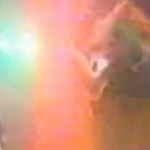
Riff Raff
When I was in San Francisco a couple weeks ago, Michael introduced Girish and me to a whole pack of Bay Area bloggers and film folk, several of whom, I was happy to discover, were eager to discuss my “Great Guitar Songs” project. It’s kind of a music geek’s wet dream, really. Just deciding which three Led Zeppelin songs to include, I’ve discovered, can kill, like, 30 or 40 minutes if you pose the question to the right coworkers.
Last weekend, when Joanna and I drove down to Chattanooga, we listened to nothing but the first draft of my 5-disc compilation. She was quick to point out a glaring omission, God bless her — “Barracuda” by Heart. I also realized that I’d taken my fondness for ’60s garage rock a bit far and needed to trim some of the fat. Also, we both agreed the collection needed some AC/DC.
Here’s something I’ve learned about AC/DC, though. Apparently they’re one of the final holdouts of the iTunes era. (I assume this goes hand-in-hand with their weird distribution deal with Wal-Mart.) None of my regular sources — eMusic, Amazon, or iTunes — sell AC/DC songs, so, instead, I drove over to Knoxville’s music mecca, The Disc Exchange, and plunked down $7.99 for a brand new copy of Powerage (1978).
Here’s something else I’ve learned about AC/DC. They rock. I mean, I’ve known AC/DC rocks since I was 9 years old and my friend Steve put Back in Black on his turntable and dropped the needle on “You Shook Me All Night Long.” What surprised me, though, is that they still rock, long after the brand of heavy metal they discovered was made into a joke by ’80s hair bands, and long after I “outgrew” my fondness for early metal.
I bought Powerage rather than one of the other, more obvious choices because it includes “Riff Raff,” hands-down my favorite AC/DC song. There’s much to love about this song — the opening crescendo, Angus’s riffs, the driving 8th-note bassline, the unimpeachable beauty of a 3-chord song — but I developed my crush on it after listening to Mark Kozelek’s What’s Next to the Moon for the 15th or 20th time. Moon is an entire album of AC/DC covers, all culled from the Bon Scott era, and all given the full-on Kozelek treatment: soft, acoustic renditions, lovingly and sweetly sung. I’ll be damned if Kozelek doesn’t turn Bon Scott into a kind of Woody Guthrie or Hank Williams — a simple man capable of transforming simple desire and simple language into heartbreaking folk poetry. Check out Kozelek’s version of “Riff Raff.” Both versions, I’ve decided, are going on my nephew’s CDs.
-
Seeking Suggestions: Great Guitar Songs
A couple weeks ago, my nephew got an electric guitar for his 13th birthday. As his desperately-clinging-to-credibility uncle (I couldn’t bring myself to use the word “cool”), I now feel a certain obligation to expose him to good music. By my 13th birthday I’d already been blowing my allowance on pop and rock records for seven or eight years, but he hasn’t heard a great variety of music. The plan is to send him a couple mix CDs that will introduce him to a broad spectrum of playing styles, guitar tones, and genres. I figure he’ll probably hate 3/4ths of the songs but hopefully a few of them will stick.
If an alien landed on your doorstep and asked you what a guitar sounds like, what songs would you play?
-
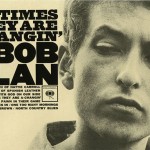
Seven Songs
The Seven Songs
- “Boots of Spanish Leather” by Bob Dylan
- “Inside a Boy” by My Brightest Diamond
- “Spirits (Having Flown)” by Bee Gees
- “A Letter to Both Sides” by The Fixx
- “Elegie in C Minor, Op. 24” by Gabriel Faure
- “Tel Que Tu Es” by Charlotte Gainsbourg
- “Revolution Earth” by The B-52s
Bob Dylan
Professor Fury has tagged me with the “7 Songs You’re Into Right Now” meme, which is good because I’ve been looking for an excuse to write about how it’s only now, thirty years after I bought my first pop/rock record, that I’ve finally entered my Bob Dylan phase. I dismissed Dylan for so many years, mostly because of that voice, which I disliked to such an extent that it fooled me into thinking his songs lack melody. I was wrong on both accounts — about the voice (more on that in a second) and the songs, which are, on average, so impossibly good that I actually feel a bit overwhelmed by it all. I could easily name seven Bob Dylan songs that I’m into right now and be done with this damn post, but my wine glass is still more than half full, and, besides, that wouldn’t be much fun, now would it? And so I give you only “Boots of Spanish Leather” from The Times They Are A-Changin’, written in 1963, when Dylan was all of 22 years old. Such a lovely lyric and melody — better than anything crafted by many great songwriters over the course of a lifetime — but what kills me is the vocal performance, which makes the song sound like it’s a hundred years old.
My Brightest Diamond
To the short list of “Darren’s Dream Jobs” you can now add “Shara Worden‘s Bass Player.” My Brightest Diamond’s second album, A Thousand Shark’s Teeth, will reach American store shelves on June 17th, and at this point I’m counting the days. If the first song from the album, “Inside a Boy,” is any indication, it won’t be a great departure from Bring Me the Workhorse, which is just fine by me. Joanna and I have played that album to death. This song is all about the bass line, which is deliriously syncopated and muddied with fuzz. Please play at high volumes.
Bee Gees
If at any point over the past three months you had found yourself in a room with me and a piano, chances are you would have already heard me ramble on about how great a song “Spirits (Having Flown)” is. No, really. You also would have heard me play and sing it. I can’t seem to stop. The lyrics are godawful, even by Barry Gibb standards, and this is one of the few instances where a disco-era Bee Gees song is hindered by the production. (The woodwinds in the bridge disappoint me every time.) But the song is amazing. That each verse includes three different Major-7 chords is enough to earn my affection, but what pushes “Spirits” into the realm of pop music brilliance is the melody, which uses those sevenths — even landing on them at the ends of phrases. (A great example is the short pause after “We go alone” around the 43 second mark. He finishes the phrase by singing an E over an F-Major chord.) “Spirits” also shifts constantly from minor to major tonalities. I especially like the G-Minor to F-Major to G-Major move in the chorus (from 1:37 to 1:43), which is followed immediately by a short key change and a complex but effortless-sounding transition back to the verse. Top-notch songwriting.
The Fixx
Joanna’s new car came with a free trial of XM radio, and I’ve been really enjoying FRED, which plays nothing but New Wave, Post Punk, and British pop of the late-’70s and ’80s. I never imagined I’d hear Husker Du and The Damned on the way to the grocery store. I tend to remember only the tinny, mechanical drumming of those pop records, but FRED has been a fun reminder of how interesting so much of the guitar playing was. Think of the Edge’s playing on War, for example, especially on “Drowning Man.” Or Johnny Marr on The Smiths’ records. Lately, I’ve been spending a lot of time with the Greatest Hits of The Fixx. Jamie West-Oram has been their guitarist for nearly 30 years, apparently, and he’s a wonderfully tasteful and inventive player. “A Letter to Both Sides,” as I’ve learned while writing this post, was originally included on the Fletch soundtrack, which only adds to its awesomeness as far as I’m concerned. Aside from having the lamest 15-second intro you’re likely to hear in some time, it’s a fantastic song that’s built around a rhythm guitar part that wouldn’t be out of place on a Nile Rodgers record.
Gabriel Faure
Fifteen years ago, when Joanna and I were just beginning to know each other, she invited me to join her in a practice room at the Florida State Music School. I was finishing up my one year as a failed music composition major there, and she was taking cello lessons for fun. We hacked our way through some piece together for about fifteen minutes then spent the next two hours talking. I’m not sure why we never tried playing together again — not seriously, at least. She’s working on Faure’s “Elegie in C Minor, Op. 24” right now, and last week I decided to join her. We’ve only made it through the first twelve measures so far, but give us time. The cellist in this recording is Steven Isserlis, and the pianist is Pascal Devoyon, from Faure: Complete Cello Works.
Charlotte Gainsbourg
On the I’m Not There DVD, Todd Haynes admits that when he finally met Charlotte Gainsbourg in person, he’d never wanted so badly to be straight. I’ve listened to her album, 5:55, more than any other over the past three or four months, and this song, “Tel Que Tu Es,” never fails to make me . . . what’s the word? . . . horny. It’s an incredibly sexy song, right? All that breath in her voice, and the unapologetically lush string arrangement? Plus, I can’t not imagine Charlotte’s face when I hear the song. Lust at first sight.
The B-52s
And finally, I end with a joke — not the song, which was always my favorite of the B-52s’ comeback singles, but the reason it’s on my mind these days. But first, two warnings: One, I know this is a “you had to be there” kind of joke, and Two, of the forty people who read this site, maybe only two or three will get the reference. So, Joanna and I are driving around one night and “Revolution Earth” comes on the radio. At about the 30 second mark, Joanna, without looking up from her magazine, says, “Is this the song Gaeta was singing after they cut off his leg?” I almost wrecked the car I was laughing so hard.
I warned you.
Edit: A little more context for the joke.
-
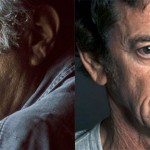
Magic and Loss
How’s this for a strange association? While marveling at Lou Reed’s performance Wednesday night, I kept thinking of Michel Subor. In Claire Denis’s L’Intrus, Subor plays Louis Trebor, a mysterious man nearing 70 whose carefully managed life is undone by a heart attack. Denis often films Subor and the other actors in close-up, emphasizing the peculiar character of their faces — the deep lines and moles and varieties of complexion. When Trebor visits a masseuse soon after his heart transplant, Denis lingers on the deep scar running down the middle of his chest. His face winces as the small woman’s fingers kneed on his scarred skin.
I went to the Lou Reed concert mostly out of curiosity and with no particular expectations. I certainly wasn’t expecting such a stellar band — featuring Rob Wasserman, Kevin Hearn, Tony Smith, and Steve Hunter — or such an affecting experience. Lou and the band ticked through the same twelve songs they’ve played every night on this tour, which meant there was little chance of spontaneity or surprise, but the setlist was tight and had a slow-burning power. (“Slow-burning power”? Really? This is why I don’t write about music.)
Back to the strange association . . .
The fourth song of the set was a 14-minute version of “Ecstasy” that completely transformed the atmosphere in the room. It begins with a drone-like prelude before settling comfortably into a shuffling verse. Lou’s minimalist guitar solo opens things up a bit — God, I love his guitar tone — and then things temporarily explode into a fit of percussion. The part that really got to me, though, was the final verse:
I feel like that car that I saw today, no radio, no engine, no hood
You know, I’m going to that cafe
I hope they got music, I hope those guys can play
But if we have to part, I’ll have a new scar right here, right over my heart
Any you know what I’ll call it? I’ll call it ecstasy.As he sang, he dragged a line with one finger over his chest and introduced a new idea — or a new sense — to the show. The deep lines in Lou’s face suddenly became more fascinating and hard-earned. There was a new melancholy in the room — a kind of painful pleasure. It’s hard to explain, and perhaps I’m the only one who felt it. A few minutes later, he sang a new song, “The Power of the Heart,” which is sentimental and sweet, even — presumably it’s a gift of sorts for his recent bride, Laurie Anderson — but, somehow, passing through Lou’s body makes the song something else. It’s that same melancholy, the sense that life is long and hard and occasionally beautiful. It’s “magic and loss,” as he sang later in the show. It’s a “halloween parade” — a roaring carnival of lost friends and lost loves.
-
40 Hours in 18 Images and 3 Songs
The Duke Spirit
Thursday Night, The Bijou Theatre, Knoxville, 9:40 – 10: 30 p.m.
If I die having never seen PJ Harvey live, I will at least be able to tell my grandchildren that I saw Liela Moss and The Duke Spirit play their first ever show in Knoxville. Michael Smith has been keeping me up-to-date on all things Spirit-related for the last two years, and after experiencing Liela first-hand, up close and personal, I owe him one. She is such a rock star. In a town like Knoxville, where crowds for this kind of show typically number in the low hundreds, her energy and joy were a real treat. She never stopped playing to the last row of the balcony, even though when the spotlights dimmed, I’m sure she could see that the balcony was empty. From what I could tell, there were maybe only four or five other people there on Thursday night who had heard of The Duke Spirit, but by intermission there was a long line at their merch table and every conversation around me was about the band.
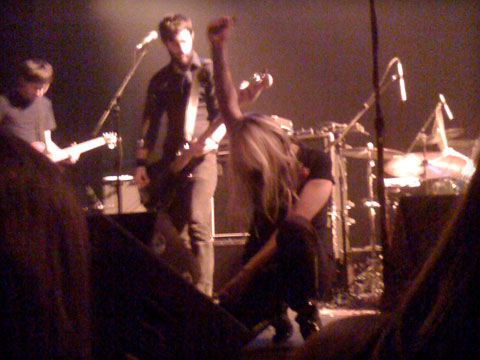
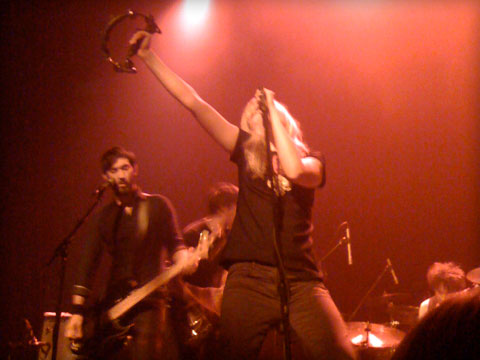
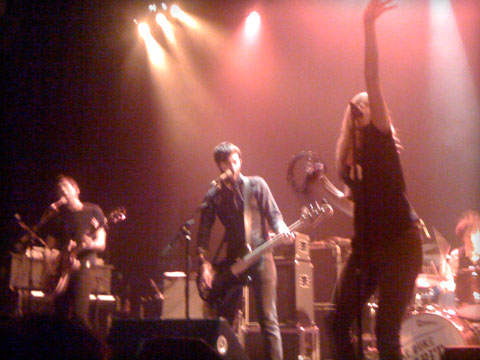
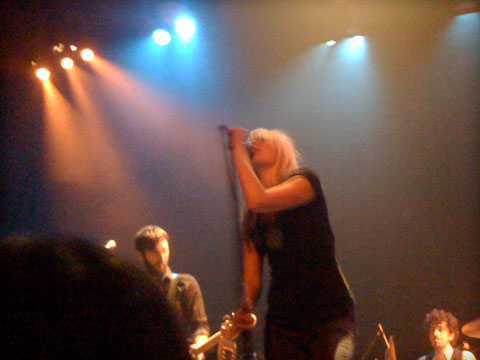
Black Rebel Motorcycle Club
Thursday Night, The Bijou Theatre, Knoxville, 10:50 p.m. – 12:00 a.m.
The most pleasant surprise of my concert-going year in 2007 was seeing Morrissey. It had been a while since I’d last experienced a rock star extravaganza, complete with wardrobe changes and a light show. (I’m now convinced he’s the Tom Jones of Generation X.) But even Morrissey, at his posing, most calculated best, isn’t as committed to an aesthetic as are the guys in BRMC. Dressed in black and silhouetted by uplighting and a barrage of strobes, they pounded their way through about 70 minutes of music before I left. It was great fun to see a hard working power trio again — bassist Robert Levon Been and guitarist Peter Hayes are both impressive — but especially after The Duke Spirit, BRMC’s act felt too much like a pose. Live music should be fun, right?
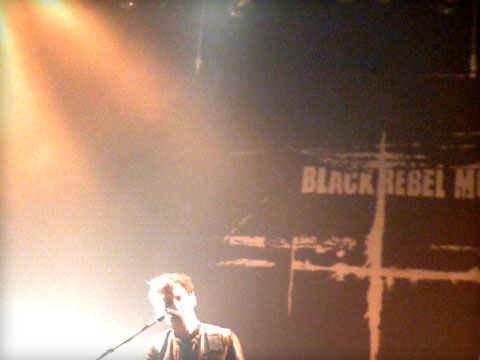
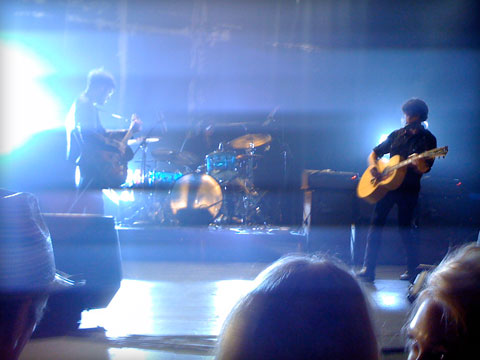
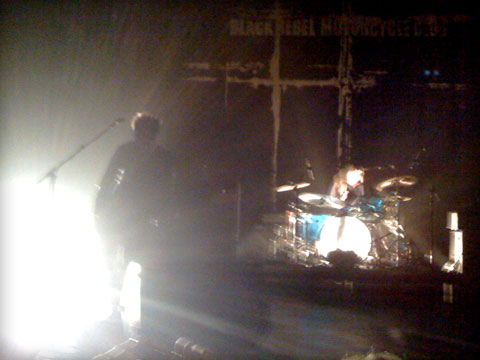
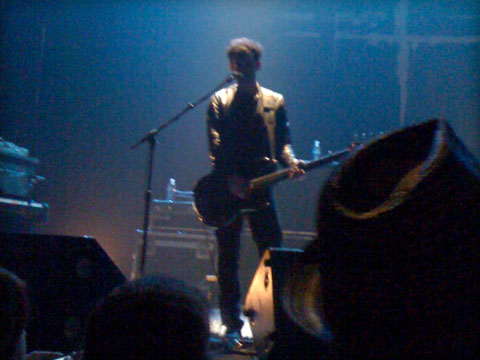
Sonic Youth
Friday Night, City Hall, Nashville, 10:20 p.m. – 12:00 a.m.
In a week or two I’m going to turn 36, and I felt it on Thursday night. The BRMC demographic, apparently, skews a bit younger. Which is one of the many reasons it was so much fun to see Sonic Youth just 24 hours later. Among the thousand or so people who packed the room at City Hall in Nashville was a healthy assortment of folks like me who bought Daydream Nation back when it was released, twenty years ago. I’d hoped we might get a surprise encore of their 2007 tour, when they played Daydream front-to-back, but, instead, we got three songs from it — “Hey Joni,” “Candle,” and “‘Cross the Breeze” — several from Rather Ripped (I still really love “Reena”), and an assortment of older material. I’m not complaining. I’m sure that if I had the opportunity to see Sonic Youth live every night for the rest of my life, I’d eventually skip a show or two, but not for some time. Being packed into a sweaty crowd, bouncing to that Sonic Youth noise, is a special kind of euphoria. Kim, Lee, and Thurston are all in their 50s now, so I figure I’ve got another decade or two in me.
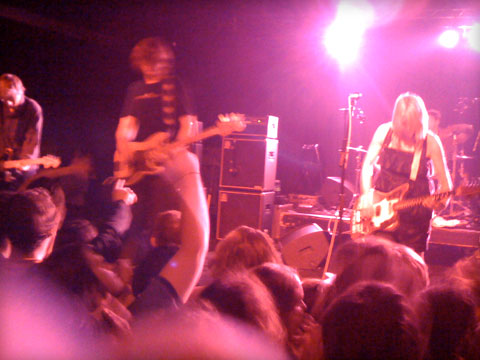
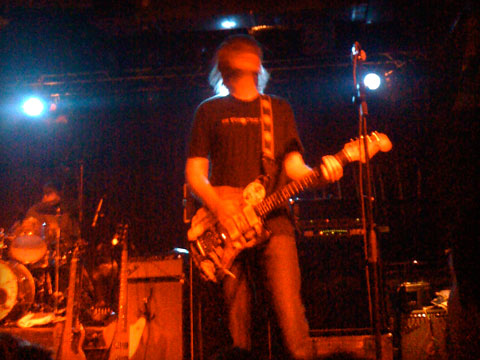
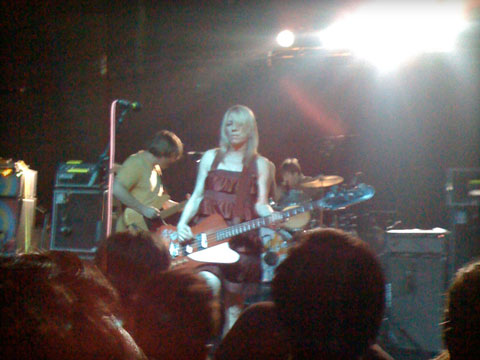
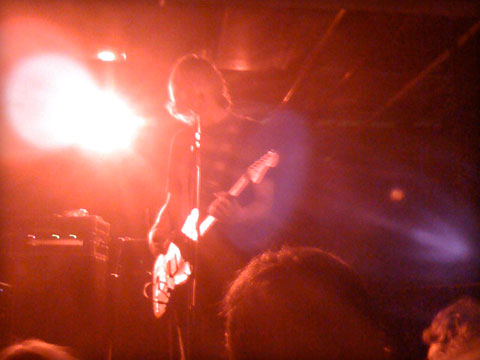
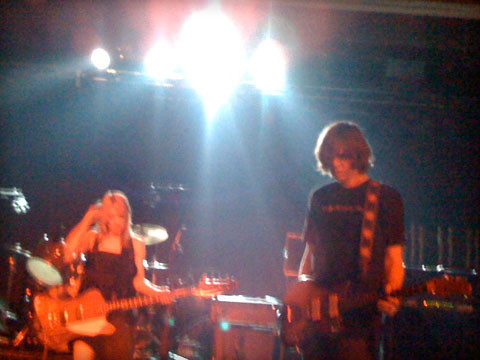
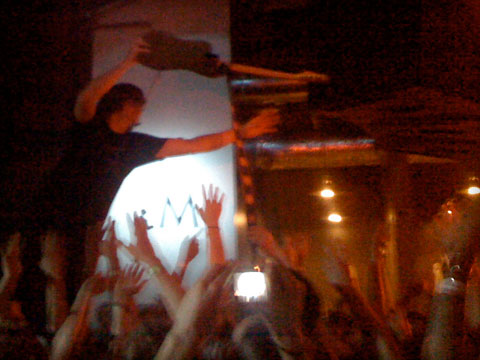
Last Year at Marienbad
Saturday Afternoon, The Belcourt Theatre, Nashville, 12:00 p.m. – 1:40 p.m.
One of my secret ambitions is to establish in Knoxville a theater like Nashville’s Belcourt. The last remaining independent theater in the city, The Belcourt is now run as a non-profit and offers a variety of film programming, live music, and drama. Notably, it is often the only theater in the southeast where audiences can see the newly-struck prints that play NYC, Toronto, Chicago, LA, and San Francisco. It’s where I saw Satantango a year-and-a-half ago and where, yesterday, I saw the same 35mm print of Resnais’ Last Year at Marienbad that played at the Castro in March. I’d seen Marienbad only one other time — seven or eight years ago when I was just beginning to discover European cinema. I remember thinking at the time, “Hmmmm, I wonder if it’s possible for a film’s drama to be located in the camera rather than in the performances?” It was that kind of breakthrough film for me. And I’m happy to say I’m no nearer to understanding it today.
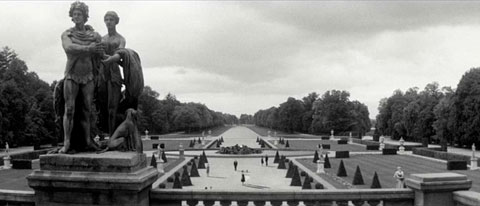
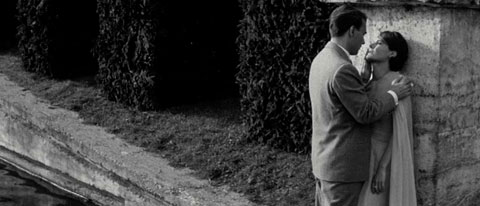
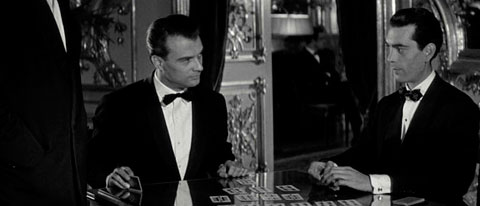
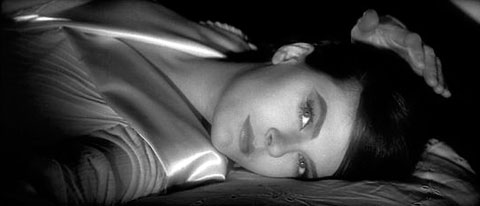
-
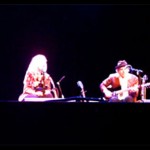
Saturday Night at Church
The picture above is deceiving. For one, I took it from my seat, with my iPhone buried deep in my chest, pointing up over the brim of the stage, so the perspective is distorted. Also, it’s actually two photos combined in Photoshop. I was sitting so close I could never get all four performers — Patty Griffin, Emmylou Harris, Buddy Miller, and Shawn Colvin — in a single shot. I was sitting so close, in fact, that the only two people in the theater sitting closer to Emmylou were Patty and Buddy (sorry Shawn).
Three Girls and Their Buddy, as they’ve named this tour, stopped by the Tennessee Theatre last night. Sitting side-by-side with no other accompaniment, each of the singer/songwriters took their turn at the mic, beginning with Emmylou (“I’m the oldest, so I get to go first”). They played for just over two hours — four cycles through plus a groupsing of “Green Pastures” and two encores, “Didn’t Leave No Body but the Baby” (the sirens’ song from O, Brother) and Patty Griffin’s gorgeous ode to her grandmother, “Mary.”
I titled this post “Saturday Night at Church” because the whole show was gospel-flavored — though after finally seeing her live, I suspect the same could probably be said of every concert Emmylou has ever played. By the midpoint of the first song, “Red Dirt Girl,” I was nearly crying. It was the damnedest thing. I’m starting to think she’s an honest-to-God angel.
-
2007 Mix CD
18 songs from 18 albums I enjoyed this year.
- “Split Needles” by The Shins from Wincing The Night Away
- “Spring And By Summer Fall” by Blonde Redhead from 23
- “Don’t You Evah” by Spoon from Ga Ga Ga Ga Ga
- “Go Places” by The New Pornographers from Challengers
- “Everybody Knows (Christmas lights version)” by Ryan Adams from Easy Tiger
- “Your Lips Are Red” by St. Vincent from Marry Me
- “Ballad Of A Thin Man” by Stephen Malkmus & The Million Dollar Bashers from I’m Not There (Original Soundtrack)
- “So You Say” by The Bird & The Bee from Please Clap Your Hands
- “Mistaken for Strangers” by The National from The Boxer
- “This Will Fall Away” by The Autumn Defense from The Autumn Defense
- “Jigsaw Falling Into Place” by Radiohead from In Rainbows
- “All the Way Down” by Oakley Hall from I’ll Follow You
- “The Nest” by Jose Gonzalez from In Our Nature
- “Impossible Germany” by Wilco from Sky Blue Sky
- “Grow Grow Grom” by PJ Harvey from White Chalk
- “Wonderful Witches” by Thurston Moore from Trees Outside The Academy
- “To the Country” by Laura Veirs from Saltbreakers
- “A Meaningful Moment Through A Meaning(less) Process” by Stars of the Lidfrom and Their Refinement of the Decline
-
David Byrne Does K-Town
“At the Holiday Inn in Knoxville, I saw a sign for the historic town center. Thinking it might contain some character and restaurants, we head there in search of dinner. There’s no one on the streets — not metaphorically, but literally not a single soul is out and it’s not even 8 o’clock. Eventually, we reach Market Square where we see people sitting at some outdoor seats. There are few restaurants, so we’re in luck. They serve me wine in a tiny plastic airplane bottle and we share a nice salad and some salmon. We wonder, where is everyone? Do they come to town to work, some of them, and then go home and stay in at night? Or do they go to restaurants and bars in suburban strip malls?”
— David Byrne -

Vermicide
A recent conversation while driving home from Lowe’s:
“How is it possible for a human voice to make that sound?”
“I think it’s Mars Volta. . . . Rush for the new millennium.”
“It’s like there has to be one of those guys every generation. It’s just wrong.”
[pregnant pause]
“But you dig the song, right?”
“Absolutely. Don’t you?”
“I haven’t changed the station yet. . . . You just like the angst.”
“Yep. That’s why most of the music you like sucks. Not enough angst.”
“Well, most people outgrow angst, like, after puberty.”
“Whatever.” -
Friday Five: Want-To-See Concerts
Here are the rules for this Friday Five:
- These are the bands/artists I most want to see live.
- I have never seen them play live before.
- They are actively writing, recording, and/or touring. (This is not a list of the top five concert tours I wish I could have seen. This is not an opportunity to resurrect Keith Moon and Joe Strummer.)
- They are still relevant, dynamic live performers. (I’d love to see a Rolling Stones concert in 1976. Today? Not so much.)
What are your Top 5 To-See Concerts?
5. Mark Kozelek
Kozelek booked a show at a small Knoxville club last year but canceled at the last minute due to sickness. That he never followed through on his promise to reschedule seems to confirm my suspicion that, for whatever reasons, he just didn’t feel like playing here. Still, I’d love to see him play live. It would be a mellow show, for sure — much mellower than the others on my list — but I’ve logged more hours with his music over the last few years than with anyone else’s, and I’d really like to experience those songs in person, for better or worse.
4. Bruce Springsteen
Barring the invention of a time machine, I suppose I’ll never get to see Bruce and the E Street Band in their hungry, mid-’70s prime, but by all accounts he still puts on a hell of a show. He’d probably register even higher on the list if there weren’t the slightest possibility of hearing “Glory Days,” “Dancing in the Dark,” or any of those other Born in the U.S.A. radio staples that made me hate Springsteen for so many years.
3. Wilco
I’m hopelessly late to the Wilco party, and, regrettably, have missed several opportunities to see them because of it, including one instance when a friend called and said, “Hey, Darren, I have tickets to a Wilco show. Do you want to go?” My response was, I think, “Nah” or “Nope” or “Thanks, but.” Pathetic. I also could have seen them in Knoxville’s beautiful Tennessee Theatre, but I skipped that one, too. Seeing Jeff Tweedy’s solo acoustic show a few months ago changed all that, though, and since I’m one of the few people, it seems, who is head-over-heels with Sky Blue Sky (especially the first 30 minutes or so, which are perfect), I’m praying they’ll make a return trip.
2. Bjork
I have no idea what a live Bjork experience would be like these days, which is one of the main reasons she’s so high on my list. There would be a whole host of people up on stage with her, no doubt, and there’d be no shortage of lights, costumes, makeup, props, and electronic noodling.
1. PJ Harvey
Numbers 2-5 are separated by a thread and, on any given day, could be replaced by ten or fifteen other acts, but PJ owns the top spot. In the last seven years, she’s played exactly three shows within 300 miles of Knoxville, two in Atlanta, one in Lexington. I’ve already decided that if she tours to support her new album this fall, Joanna and I will be planning a trip or two around it. (Another reason I have a crush on my wife? I’ve heard her sing every word of “The Letter.”) Is there anything sexier than a beautiful, intelligent woman playing a loud guitar?
-
Mix CD: It’s Beautiful Now
A month or two ago, a guy at work invited me to join his “prayer meeting.” For those of you who’ve never ventured south of the Bible belt or who didn’t grow up Baptist, prayer meeting is where a good number of church folk spend their Wednesday evenings. It’s a time of fellowship and support and meditation (though in my experience most who attend would bristle at that word, meditation, which reaks of godless Eastern religion and, frankly, hippies). But anyway . . .
Our prayer meeting is held at Preservation Pub, which boasts a distinct advantage over most official houses of prayer in that it pours cheap pints of Guinness and Smithwicks. Also, it has a killer jukebox and a poster of Woodie Guthrie playing his “This Machine Kills Fascists” acoustic guitar. The Pub is on Market Square, just a few doors down from where Suttree goes to sell his fresh catch, and it feels good and old inside.
So on most Wednesdays now I head straight from work to the Pub, where I meet up with an always-different assortment of
interesting characters, many of whom have been meetin’ together like this for years. And then, a pint or four later, a small group of us grab our instruments and walk a few blocks to a downtown office, where we hack and sing our way through the Neil Young, Bob Dylan, Everly Brothers, The Band, and Pink Floyd songbooks. Last night I discovered, proudly, that I know every word to “Wish You Were Here” and can sing it, too.I made this mix for the other guys at prayer meeting, nearly all of whom are about a half-generation older than I am. We all grew up listening to the same music, though. They bought vinyl in the new releases bin; I saw the reunion tours. Roughly, the guidelines for the mix were:
- Music they’d like.
- Music released during the last five years.
- Music from albums that I could strongly recommend.
I made a couple exceptions on guideline #2 but I think they’re justifiable. A friend listened to the mix and told me it sounded like an anthology of mellow songs of the ’70s, which I take as a mark of success. As usual, if you want a copy, send me your snail mail address (or leave a comment). I’d love something in return but it’s not expected.
Side 1
1. “Cold Roses” by Ryan Adams, from Cold Roses (2005)
2. “So It Goes” by Anders Parker, from Tell It To the Dust (2004)
3. “The Race is On Again” by Yo La Tengo, from I Am Not Afraid of You and I Will Beat Your Ass (2006)
4. “A Good Man is Hard to Find” by Sufjan Stevens, from Seven Swans (2004)
5. “Feel You Now” by The Autumn Defense, from The Autumn Defense (2007)
6. “Tampa to Tulsa” by The Jayhawks, from Rainy Day Music (2003)
7. “Theologians” by Wilco, from A Ghost is Born (2004)
8. “Water Ban” by The Pernice Brothers, from Yours, Mine & Ours (2003)
9. “Stacked Crooked” by The New Pornographers, from Twin Cinema (2005)Side 2
10. “Living Proof” by Cat Power, from The Greatest (2006)
11. “Glenn Tipton” by Sun Kil Moon, from Ghosts of the Great Highway (2003)
12. “Roscoe” by Midlake, from The Trials of Van Occupanther (2006)
13. “Effigy” by Uncle Tupelo, from 89/93: An Anthology (1993)
14. “House Carpenter” by Oakley Hall, from Gypsum Strings (2006)
15. “The Past and Pending” by The Shins, from Oh, Inverted World (2004)
16. “Black Star” by Radiohead, from The Bends (1995)
17. “Black Star” by Gillian Welch & David Rawlings, from Black Star EP (2004)
18. “Broken Chair” by Luna, from Rendezvous (2005) -
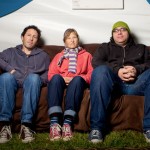
By the Time It Gets Dark
First great show of 2007: Lambchop and Yo La Tengo. Unfortunately, YLT’s last visit to Knoxville was memorable for reasons having little to do with the amazing music that was played that night. But they came back anyway, God bless ’em, and this time they played to a large and rapt audience at the Bijou. They closed the show with this cover of the old Sandy Denny song, “By the Time It Gets Dark,” and I’ve probably listened to it a hundred times since. And I have to mention this: thanks to the kindness of a friend, I not only got to hang out with Georgia for a while and drink a beer from the YLT stash; I actually drove Georgia and Ira’s van. That smell you smell is indie rock cred. I reek of the stuff.
-
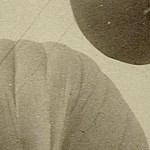
Mix: Needle Drops
Ever since Mr. Blonde carved up that guy to the sound of Stealer Wheel’s “Stuck in the Middle with You,” a certain brand of American “indie” cinema has been defined (and marketed) as much by its “needle drops” (the use of pre-existing music) as by its mode of production and distribution. Think “Sister Christian” in Boogie Nights, “Making Time” in Rushmore, and “The Seeker” in American Beauty. The practice hardly began with Quentin Tarantino and Zach Braff, of course. The American filmmakers of the ’60s and ’70s were/are especially good at it. “The End” in Apocalypse Now. “Layla” in Goodfellas. Assemble a small group of even casual film watchers, give them ten minutes, and I bet they could put together a list of a hundred more examples.
This mix began with a single iTunes download. My all-time favorite needle drop accompanies my favorite sequence in what also happens to be my favorite film, Andrei Tarkovsky’s Mirror. Midway through the film, Tarkovsky interjects a strange sequence in which a party of Spanish immigrants tell stories of the Civil War and bullfighting. (It’s all part of his on-going meditation on the meanings of nostalgia.) Tarkovsky augments their stories with found footage of Spaniards fleeing the war, building his montage to a crescendo with the sounds of frantic crowds and squealing trains and ending on a shot of a young, frightened girl who stares directly into the camera. And then silence. And a cut to more found footage — this time of early Soviet ballooners and a ticker-tape parade. I always cry at the precise moment Tarkovsky fades in the sound of Pergolesi’s “Stabat Mater, No 12: Quando corpus.”
So what we have here is a collection of some of my other favorite needle drops. Some are meaningful to me because of their placement in a film I adore (“The Rhythm of the Night” from Beau Travail, for example). Others are memorable only because they are unexpected surprises in an otherwise disappointing film (“You Know, You Know” is about the only thing I loved about Egoyan’s Where the Truth Lies.) Regardless, each of these songs/pieces is now inextricably bound in my memory to a particular scene and the emotions it evokes.
- “Golden Hair” by Slowdive
Mysterious Skin (2004) dir. Gregg Araki - “Safeway Cart” by Neil Young
Beau Travail (1999) dir. Claire Denis - “Die Walkure: Orchestervorspiel” by Richard Wagner
Birth (2004) dir. Jonathan Glazer - “I Put a Spell on You” by Screamin’ Jay Hawkins
Stranger than Paradise (1984) dir. Jim Jarmusch - “You Know, You Know” by Mahavishnu Orchestra
Where the Truth Lies (2005) dir. Atom Egoyan - “Trouble” by Cat Stevens
Harold and Maude (1971) dir. Hal Ashby - “Gayane Ballet Suite” by Aram Khachaturyan
2001 (1968) dir. Stanley Kubrick - “Snow” by The Innocence Mission
In the Bathtub of the World (2001) dir. Caveh Zahedi - Tunic (Song for Karen)” by Sonic Youth
Irma Vep (1996) dir. Olivier Assayas - “Heart of the Sunrise” by Yes
Buffalo ’66 (1998) dir. Vincent Gallo - “Once I Was” by Tim Buckley
Coming Home (1978) dir. Hal Ashby - “Coney Island Baby” by Lou Reed
Vertical Ray of the Sun (2000) dir. Tran Anh Hung - “Also Sprach Zarathustra” by Deodato
Being There (1980) dir. Hal Ashby - “Stabat Mater: Quando Corpus” by Giovanni Pergolesi
Mirror (1975) dir. Andrei Tarkovsky - “The Rhythm of the Night” by Corona
Beau Travail (1999) dir. Claire Denis
- “Golden Hair” by Slowdive
-
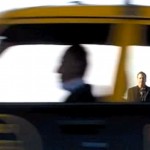
Waist Deep in the Big Muddy
“Well, I guess you ain’t never seen anything as big as this country.”
“Yes. A couple of oceans.”William Wyler’s The Big Country (1958) is one of those westerns about men proving themselves in the unforgiving and sublime conditions of the American southwest. Gregory Peck, a dandy sea captain from back east, rides into town to claim his bride and immediately finds himself embroiled in a raging family feud over “the Big Muddy,” a tract of land that offers the only source of water available to both families’ thousands of head of cattle. It’s a beautifully photographed film that goes out of its way — most notoriously in the big fist fight between Peck and Charlton Heston — to dwarf man by the surrounding landscape. Consider the latest batch of Songs of the Moment music to listen to while riding through the big country.
I first heard Richard Shindell more than a year ago when a friend posted “Che Guevara T-Shirt” on his blog, and I immediately fell in love with Shindell’s voice. “Waist Deep in the Big Muddy” seemed an obvious choice for this batch of tunes. His song is set in Louisiana, but, as far as I’m concerned, that’s entirely beside the point.
-

Aimee Mann at the Bijou
I’d brought along Joanna’s bite-sized Sony Cyber-shot camera in hopes of getting some decent stills, but the light was too low (even from the third row) and, as a result, all of the photos were streaked by motion blurs. So, instead, I experimented with the video capture, and I’m really pleased with the results — especially with the sound.
The show was a lot of fun. As her band members joke on the Live at St. Ann’s Warehouse DVD, Aimee Mann can only stand to tour for a few weeks at a time. Apparently, she’s a bit of a homebody. Her show at the Bijou last Wesdensday was the last night of this “acoustic” tour (she brought along a bass player and pianist), and she celebrated by opening up the middle of the set to audience requests. Instead of just responding to shouts from the crowd, though, she placed a box at the edge of the stage and invited us to fill it with written requests. Those whose songs were selected (at random) not only got to hear a spontaneous performance of their request but were also invited on-stage to play bongos and received a gift basket comprised of what Aimee referred to as “tour bus leftovers” — unopened Clif bars, peanut butter, and jelly; a re-gifted vegan snack basket; an assortment of soaps, gels, and a loofah; and the one genuinely cool prize, two books Aimee had read on the bus but now couldn’t fit in her suitcase (Jonathon Kozol and Patricia Highsmith, if you’re curious.)
That she’s a bit introverted doesn’t prevent Aimee from putting on a great show, though. She’s just an incredibly charming woman — talented, beautiful, self-effacing, funny.
-
Live Music

[With apologies to Richard Linklater, Philip K. Dick, and Rory Cochrane.]
Singer, songwriter, guitarist, piano player, work-a-holic Ryan Adams has a reputation for being a belligerent asshole, which, apparently, is doubly true when he brings his show to Knoxville. His concert at the Bijou two weeks ago lasted just over an hour, making it, by comparison to other stops on this tour, exactly half a concert. At 11:05 he looked at his watch and then spoke to us for the first time all evening, launching into a tirade against someone at his record label who had apparently rejected his latest batch(es) of songs. Since he was already five minutes beyond the curfew — or so he informed us — the show was over. He walked off stage, his bass player thanked us for coming out, the roadies began tearing down the gear, and we in the sold-out crowd eventually — and in disbelief — filed out.
But this post isn’t about Ryan Adams’ hissy fit. Or his distracting resemblance to Freck in A Scanner Darkly. Or the fact that The Bijou has never had a curfew. No, this post is about live music. And it’s about the years I spent as a broke-ass graduate student, unable to afford to see the shows that came through town. And it’s about the beautiful, beautiful Bijou Theatre, which, since reopening a few months ago, has booked a steady stream of fantastic acts, making Knoxville — finally — a worthwhile stop for all of those bands traveling to and from Nashville, Atlanta, and Asheville. Midway through his opening set the other night, Cardinals guitarist Neal Casal actually stopped for a minute or two to compliment the theater. “Usually a show only sounds good out where you’re sitting,” he told us. “But tonight it sounds really good up here, too.”
I’ve only seen two shows at the Bijou so far, Ryan Adams and Richard Thompson, but I have tickets for four more over the coming weeks.
- Bruce Cockburn, August 30, second row center
- Rhys Chatham, September 5, second row center
- Calexico and Oakley Hall, September 21, front row center
- Aimee Mann, October 4, third row center
Not bad, eh?
-

The Origin of Love
This is the second time “The Origin of Love” has been a Long Pauses Song of the Moment. Again, I was inspired by seeing a live performance of Hedwig and the Angry Inch — this time here in our own “scruffy little city,” Knoxville, Tennessee. K-Town did me proud. The Actors Co-op’s production is funnier, and its music is better, than the version we saw in Washington, D.C. three years ago. The show lives and dies on its Hedwig, and Joseph Beuerlein is impressive. I don’t know how anyone can do a two-hour show and still have the voice to shout “Lift Up Your Hands” at the end of “Midnight Radio,” but Beuerline just got stronger and stronger. My only complaint is that he’s a little too butch. For the play to really work, Hedwig must seduce everyone in the audience, including the heterosexual men, and he never quite did. (His effect on my wife is another story.)
Jonathan Richman’s version of “The Origin of Love,” like the other links I posted yesterday, are all from Wig in a Box, which is perhaps the only “music from and inspired by” cover record I’ve ever heard that’s a fantastic album on its own terms. Hedwig‘s best songs — “Origin,” “Wicked Little Town,” “Wig in a Box” — are each given straight (no pun intended), respectful readings. Rufus Wainwright’s version of “Origin,” for example, sounds exactly like you’d expect it to sound. And The Polyphonic Spree’s cover of “Wig” is the only one of their songs I can stand to listen to a second time.
What I love about the album, though, is its inspired reinventions. Spoon turns “Tear Me Down” into a Tommy-era Who song, and the pairing of Yoko Ono and Yo La Tengo on “Hedwig’s Lament / Exquisite Corpse” is just brilliant. Robyn Hitchcock’s “City of Women” won’t change the world, but it makes me strangely nostalgic for Bauhaus and Peter Murphy records.
-
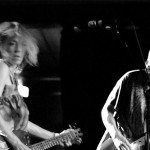
Drunken Butterfly
Or, Random Observations Provoked by Seeing Sonic Youth Live for the First Time:
- Sonic Youth’s show in Asheville, NC this past weekend seems to have served two purposes for the band: It was a logical stop on I-40 as they made their way west toward that music festival over in Manchester, and it gave them another chance to road test material from Rather Ripped.
- Lee Ranaldo, apparently, is most in need of the practice. I noticed him laughing to himself several times as he fumbled his way through a couple of the new songs. They played all but one or two of them, and a couple really came to life. “Pink Steam,” “Turquoise Boy,” and “Rats” were probably the highlights.
- I’ll likely never get a chance to see Spinal Tap play “Big Bottom” live, but I’ve now seen Thurston Moore, Kim Gordon, and Mark Ibold all play bass on “Eric’s Trip.”
- That spinning, rocking, jumping-jacks thing Kim Gordon does? She could totally put out a “Rad Mother” workout video. I’ve now seen her calves from about ten inches away, and, I’m telling you, they belong on a woman half her age. 53? Are you kidding me?
- “Drunken Butterfly” (mp3) was the best three-and-a-half minutes of my concert-going life.
- I need to go to more shows that risk permanently damaging my hearing. Bad for the ears, good for the soul.
- Damn, that was fun.
-
David Sancious
During the late-80s and early-90s, when I was preparing for what would prove to be a remarkably short stint in music school, much of my listening was piano-centric. I’ve already owned up to my obsession with all things Yes, but in earlier posts I was hesitant to admit just how deep those waters ran. For example, I not only owned, but proudly proclaimed the brilliance of Rick Wakeman’s solo albums, including the one he [shudder] staged as an ice show. I camped out for tickets to an Anderson, Bruford, Wakeman, and Howe concert. I spent hours and hours trying to learn his “Six Wives of Henry the VIII” solo from Yessongs. I booed and hissed at the mere mention of Tony Kaye’s or Trevor Horn’s name. (Only Patrick Moraz’s playing on Relayer was up to Wakeman’s standard.)
Good lord, it’s like I’m speaking some long forgotten dork language. And I haven’t even mentioned Keith Emerson yet.
The player I most envied then was David Sancious. Not because he had Wakeman’s dexterity or massive rig of keyboards, but because he sat in both of my dream chairs. In 1988 Sancious joined Peter Gabriel’s band for the So tour and for the series of Amnesty International Human Rights Now concerts that followed. (That lineup, by the way — Sancious, Tony Levin, David Rhodes, and Manu Katche — is featured in the regrettably-not-on-DVD concert film, Point of View [PoV], best remembered today for the version of “In Your Eyes” that got some play on MTV after Say Anything made it a hit.) Sancious also joined Gabriel in the studio, lending his tasteful playing to both Passion and Us.
From Gabriel’s band, Sancious then moved over to Sting’s. A note for any reader who is too hip for Sting: Get over yourself. Yeah, he’s taken the Elton-John-Disney route in recent years, but those first few solo albums are like songwriting 101. If you can’t appreciate a good lyric, a beautiful melody, and the most tasteful bass playing this side of Revolver, well . . . maybe this site is more to your liking. Sancious recorded and toured with Sting throughout the early-90s, often sharing duties with Kenny Kirkland. (Has it really been eight years since he died?) He can be heard on both The Soul Cages and Ten Summoner’s Tales.
For most fans of rock music, though — fans who didn’t spend their teen years arguing over which was the coolest Roger Dean album cover — Sancious is best remembered for his time with the E Street Band. He and Springsteen met when both were still in their teens, but in 1972, when Springsteen set out to record Greetings from Asbury Park, N.J., he had to recruit Sancious, who was then living in Virginia. He returned to New Jersey for the gig and stuck around long enough to play on the followup album, The Wild, The Innocent, and the E Street Shuffle, and on the title track of Springsteen’s third record, Born to Run. After two years of recording and touring with the Boss, Sancious left to form his own band, Tone.
It’s only been in the last few months that I’ve discovered those first three Springsteen records. It’s a breakthrough, really. I’m treading through a thick soup of anti-Springsteen bias that first began to congeal in 1984, when every damn time I turned on the radio I heard “Glory Days,” “My Hometown,” or “Dancing in the Dark.” I still really hate those songs. Springsteen’s early recordings, though, are just amazing. Messy, loud, and a shitload of fun — like a Stax review had stumbled into some East Coast beer hall.
About three-and-a-half minutes into “Kitty’s Back,” just after Springsteen’s blaring, horn-backed solo, Sancious steps in with a squirrelly run on his Hammond organ, followed by a slew of percussive figures and arpeggios. Harmonically, it isn’t an especially interesting solo, but it’s exactly the kind of Booker T-inspired playing the song needs. (Compare with Sting’s “Saint Augustine in Hell,” one of the few songs I can think of that finds a deep groove in a 7 time signature). I suspect that his taste and restraint are exactly what Springsteen, Gabriel, and Sting most like about Sancious. All three put The Song on a pedestal and surround themselves with musicians who do the same.
-
Electrif Lycanthrope
How’s this for throwin’ down the gauntlet? I would put the six studio albums Little Feat recorded between 1971 and 1977 up against any other collection of records by an American band over that same period. And, if shipped off to that proverbial desert island with only a record player and one live album by a rock and roll band, I wouldn’t think twice before grabbing my copy of Little Feat’s 1978 masterpiece, Waiting for Columbus. Nearly twenty years after hearing it for the first time, I still play all or parts of Columbus every month or so. (If you want to check it out now, be sure to buy the expanded 2-CD set that was released in 2002.)
Little Feat was formed in 1969, when singer/songwriter/slide-guitar player Lowell George and bassist Roy Estrada left the Mothers of Invention and teamed up with drummer Ritchie Hayward and pianist Bill Payne. After a couple years and two albums together, Estrada left and the band reformed as a six-piece, adding guitarist Paul Barrere and percussionist Sam Clayton; Estrada was replaced by Kenny Gradney. When the lineup expanded, the band’s sound got dirtier and the pocket got deeper — less Southern California (George was from Hollywood), more New Orleans; less Flying Burrito Brothers or Captain Beefheart, more Dr. John or The Meters.
Along with one of the best rhythm sections ever assembled, it has George, Payne, and Barrere, all three of them talented singers and songwriters. I’ve singled out the first six albums, though, because those are the recordings that feature Lowell George at the top of his game. By 1976 or so, the drug problems that would kill him three years later were beginning to take their toll on him and the band. “Day at the Dog Races,” the fusion-inspired instrumental on Time Loves a Hero (1977), was supposedly written during one of George’s many missed rehearsals. And, in fact, on their commentary track for the Live at Rockpalast DVD, Payne and Barrere laugh when they see George leave the stage during the song, joking that it was his habit during that tour to use “Dog Races” as a break to get, um, re-medicated for the rest of the show.
As George became more and more distracted by drugs and by other projects (he produced The Grateful Dead’s Shakedown Street and recorded a fantastic solo album, Thanks, I’ll Eat It Here), Payne and Barrere took over the bulk of the writing chores, and the band’s sound made a slight turn toward the jazz rock of the era. “Red Streamliner,” also from Time Loves a Hero, even features backing vocals by the then-ubiquitous Michael McDonald. I actually like the song and the sound of those records quite a lot, but the shift from Little Feat in 1971 to Hero just six years later is stark. The band reformed a decade after George’s death and have recorded and toured almost constantly since. In fact, they’re playing a free show here in Knoxville on Thursday night, though I won’t be able to see it.
For years, I’ve heard and read about Electrif Lycanthrope, an unofficial live release from 1974. Original vinyl copies still show up on the market from time to time, though at prohibitively steep prices. But now, thanks to the wonders of the Internet Archive, it’s right there, just waiting to be downloaded for free. God bless the internets!
-
Music Hall MMF 2.1
I have no will power. Barely two weeks after deciding that I’d like to pick up a turntable, I now own a Music Hall MMF 2.1. I’m justifying the expense by reminding myself that, in two weeks, I won’t be spending several days in New York with Brian, Girish, and Acquarello, I won’t be attending the Rendezvous with French Cinema series, and I won’t be eating fabulous meals or seeing live music or visiting museums or doing any of the other expensive things I had intended to do before a family obligation forced a change of plans.
Every review I could find described the MMF 2.1 as a great bang-for-the-buck table. (I ordered direct from J&R, who shipped it quickly and triple-boxed it for safe delivery.) After more than a decade of using nothing but solid-state electronics, I can’t quite express how much fun it was to spend nearly an hour assembling and calibrating a piece of audio equipment. The wood deck, manual belt drive, and delicate tonearm assembly gave me the sense that I was handling a musical instrument rather than the kind of sterile “players” (CD, DVD, mp3) I’ve been living with for so long.
(In case any audiophiles stumble upon this post: I’ve connected the MMF 2.1 directly to the phono input on my Denon AVR-3805 receiver, which is driving Paradigm Studio 40 speakers and a Klipsch subwoofer.)
Some thoughts on listening . . .
“Babylon Sisters” — The first LP I queued up was Steely Dan’s Gaucho. (I found a factory-sealed copy last weekend at a record show.) Because I had to make a 20-decibel volume adjustment each time I switched between the phono and CD inputs, it was difficult to make a direct A-B comparison, but I feel pretty confident saying that I prefer the sound of the LP over the CD. The LP is warmer and less fatiguing, with more depth in the middle frequencies and less of the tinny compression that mars even well-engineered CDs.
“All Along the Watchtower” — From Michael Hedges’s Live on the Double Planet. I have a longer Michael Hedges post in the works, but for now I’ll just say that I suspect my copy of this album was once the property of a radio station. Either that or the previous owner just really liked Hedges’s cover of Sheila E.’s “A Love Bizarre” (the record’s single, as I recall). That one track has obviously been played to death on this particular LP — the abuse can be seen and heard.
“Subdivisions” — I bought Rush’s Signals the week it was released. 1982. It’s one of the six or seven LPs I’ve held on to over the years, but last night was the first time I’d heard it since the late-80s. The nostalgia almost gave me a seizure. I swear I recognized every pop and hiss on that record.
“Thunder Road” — No, I don’t yet own a copy of Born to Run, but on Sunday I picked up The Brave and the Bold from Tortoise and Bonny ‘Prince’ Billy. I would love to make their cover of “Thunder Road” my new Song of the Moment but I can’t. In fact, the only way I can hear it is by going down to my basement, turning on my stereo, and queuing up Side 1. It feels so strange to surrender control of my listening experience like that.
And a bit of movie music trivia. Now that I have a working turntable, I’m feeling the itch to recreate one of my favorite film moments: the opening title sequence of Harold and Maude. As you might recall, the film begins with a medium-long shot of Harold (actually, we don’t yet know it’s Harold because we can’t see his face) as he walks across the room to his record player and puts on Cat Stevens’s “Don’t Be Shy.” But here’s the thing — because “Don’t Be Shy” was written specifically for the film, and because no official soundtrack containing the song was ever released, “Don’t Be Shy” didn’t actually appear on vinyl until thirteen years later, when Cat Stevens released Footsteps in the Dark, the second volume of his greatest hits. In other words, I need to get my hands on a copy of Footsteps in the Dark on vinyl.
-
The Tyranny of “Shuffle”
I’m thinking about buying a turntable and putting together a decent two-channel stereo system. I own fewer than twenty LPs, all hold-overs from my junior high days, and I’m not aware of any place in town that has more than a handful of records for sale, new or used. But I like the idea of having a stereo because of the discipline it requires.
When I was in high school, a friend of mine came up with a sniglet (remember sniglets?) for that moment immediately after a song on the radio ends, when you, as a reflex, begin singing the song that follows it on the album. For example, you tune-in to your favorite classics station just as “Black Dog” is ending and you immediately begin singing “Rock and Roll” (because “Rock and Roll” is the next song on Led Zeppelin IV), or, while flipping the dial in some alternate universe called Amazing Radio Land, you hear the final chords of “Teen Age Riot” and launch straight into “Silver Rocket” (because they’re back-to-back on Daydream Nation). I can’t remember the sniglet my friend invented, but “prevox” should suit our purposes.*
I very rarely “prevox” these days. And I blame the “shuffle” feature on iTunes. At the moment, I have 1,481 songs on my computer (apparently that’s four days’ worth of music), and my general practice is to listen to them all in shuffle mode, as if I were programming my own perfect radio station. What’s lost in all of this, though, is the idea of an album-as-coherent-work. Of the many new releases I’ve bought over the last three or four years, there are only a few that I know and understand as albums. I could “prevox” if I heard a track from The Pernice Brothers’ Yours, Mine, Ours or Sufjan Stevens’s Seven Swans or, maybe, Mark Kozelek’s What’s Next to the Moon. Oh, and Ben Folds’s Rockin’ the Suburbs. But that’s about it.
There’s no effort required to shuffle. And, even worse, no creativity. Listening becomes a wholly passive act, and the music suffers, dissolving into the atmosphere like so much Muzak.
If asked to name my favorite albums, I would think first of the records and tapes that I studied one side at a time. I know, almost intuitively now, that side 1 of Peter Gabriel’s Security ends with “The Family and the Fishing Net” because that song is so wrought with drama that I need to flip the album to hear the (relatively) soulful “Shock the Monkey.” I know that Little Feat’s Feets Don’t Fail Me Now ends with “The Fan” and a ten-minute, jam-filled medley of “Cold, Cold, Cold” and “Tripe Face Boogie” because, when you’re a Little Feat fan, that is precisely what you’ve been waiting to hear.
So I’m thinking that a stereo will help to make music a more active experience again. Or maybe that’s my self-deluded justification for fetishizing a hobby. Maybe I’m just itching to spend money. Or maybe I should stop reading Nick Hornby.
Any suggestions for buying a turntable?
* And please feel free to offer alternatives to “prevox.” Joanna thinks it should be a noun, denoting the experience, rather than a verb that describes the action.
-
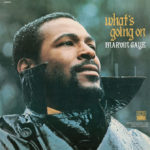
Inner City Blues
I was nineteen or twenty when I first heard What’s Going On. I remember checking it out from the library and playing the title track and “Mercy Mercy Me” over and over and over again. I was literate enough at the time to understand that this album was important — that it marked some kind of radical departure from the earlier, “Heard It Through the Grapevine”-style pop that Gaye was known for. (I think this was the same period when I was listening to the first box set of Stax singles — my teenaged “soul” period, I guess you could call it.) But at the time, the only opinion I would have offered up with any confidence was that “What’s Going On” and “Mercy Mercy Me” were two of the most beautiful songs I’d ever heard. They still are. Obviously.
I suspect that “Inner City Blues” didn’t hit me with the same force then for two reasons. The first goes back to a complaint I’ve heard my dad make fifty or sixty times over the years: “When’s that chord gonna change?” (I heard it most recently a few weeks ago, when I played for him Radiohead’s “Everything In Its Right Place,” followed by Brad Mehldau’s version, both of which left him underwhelmed.) When I was nineteen or twenty, I was playing piano several hours a day — practicing at home and playing in a community big band, all in preparation for what turned out to be a remarkably short and unsuccessful stint in music school. I was taking theory and music history courses, discovering Bartok and Stravinsky and Debussy, and trying, for the first and only time in my life, to “be a composer.” Which is to say that I could appreciate the songwriting of “What’s Going On” and “Mercy Mercy Me” like I was learning to appreciate Gershwin, Basie, Ellington, and Satie.
If I’m remembering theory notation correctly, the change for “Inner City Blues” is i-IV. Two chords. It opens with twenty-four straight measures of the minor root before finally changing to the major IV, where it stays for all of four measures before returning to the root. Would have bored me senseless a decade ago; now, I’ll be damned if that change ain’t transcendent. The song is a chant-like, soul-filled lamentation. An angry prayer.
The other reason I’m dumb-struck by this song right now is because I’ve been reading Mark Kurlansky’s 1968: The Year that Rocked the World, a social history of the period out of which What’s Going On was born. I’ve spent most of the last year reading and writing about the late-1960s and early-1970s, an era the twenty-year-old version of myself ignorantly dismissed as a distant history populated by hopelessly naive hippies who happened, from time to time, to produce some decent music. I knew about the war and the Movement and the assassinations, but I didn’t understand the anger. The anger is all over What’s Going On, and it’s in constant tension with all that beauty. That’s what I didn’t get the first time, and that’s what makes “Inner City Blues” the perfect final note to a perfect album.
-
A Session of Dance Music
A few days ago, Joanna, displaying her typical grace and tact, informed me that my last mix CD sucked. “They all sound the same,” she told me. I’ve tried on many occasions since to explain to her that that particular collection of songs is actually quite diverse, that the “sameness” she hears is, in fact, coherence, and that coherence is what makes a good mix CD good.
But rationality only goes so far in such discussions (it goes nowhere at all, truth be told), because what Joanna really meant was something closer in spirit to, “Your remarkably coherent mix CD sucks because I don’t like any of the songs on it — well, except for The Tindersticks track, which is pretty great but only in small doses, and, seriously, stop playing that Alice Cooper song or I’ll hurt you.”
And, so, one of my goals with this latest mix, “A Session of Dance Music,” was to gather some songs that wouldn’t inspire Joanna to take sarcastic jabs at my piss-poor taste. We just got back from a long drive, during which we listened to the entire disc, and her opinion seems to hover somewhere in the “Well, at least it doesn’t suck” range. So mission accomplished, I guess.
Really, though, this mix evolved a few nights ago, when a I turned off nearly all of the lights in my basement and spent two or three hours listening to songs that make me dance. By “dance,” I don’t mean that thing done by coordinated, un-self-conscious people when they hear Sam Cooke or Usher or Kool and the Gang. I mean that thing done by uncoordinated, deeply self-conscious people — people who feel more at ease, say, blogging or reading. Let’s face it: I spent two or three hours shuffling from side to side, playing air guitar, and, ahem, singing.
The longest song on this mix (“Graveyard Shift”) clocks in at 4:45; nearly all of the rest come in under three-and-a-half minutes, which, to my mind, is just about the uppermost limit for a dance song. All but two or three have really nice melodies, and most are guitar-driven. They’re pop songs, though of a louder, noiser, and certainly less-sugar-ier variety, and I love them all.
If you want a copy, drop me an email. As usual, I’d prefer to make it a swap but don’t mind sending out a few gimmes. (Oh, and I apologize to the two or three of you who still haven’t received the last mix. Send me a reminder, and I’ll drop both in the mail for you.)
1. “The Cigarette Girl from the Future” by Beauty Pill
2. “I Don’t Wanna Go Down to the Basement” by The Ramones
3. “Mr. Soul” by Buffalo Springfield
4. “Free” by Cat Power
5. “What Difference Does It Make?” by The Smiths
6. “Stroll On” by The Yardbirds
7. “Cinema Style” by Black Taj
8. “Start!” by The Jam
9. “Kool Thing” by Sonic Youth
10. “Hey Gyp” by The Animals
11. “It’s Alright for You” by The Police
12. “Wave of Mutilation (U.K. Surf)” by The Pixies
13. “Bathsheba Smiles” by Richard Thompson
14. “Graveyard Shift” by Uncle Tupelo
15. “One Time Too Many” by PJ Harvey
16. “Little Miss Strange” by The Jimi Hendrix Experience
17. “Moral Kiosk” by R.E.M.
18. “The Laws Have Changed” by The New Pornographers
19. “There She Goes Again” by The Velvet Underground
20. “Hateful” by The Clash
21. “Love Will Tear Us Apart” by Joy Division
22. “The Good Ones” by The Kills
23. “Sometimes I Remember” by The Pernice Brothers
